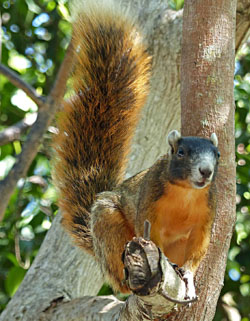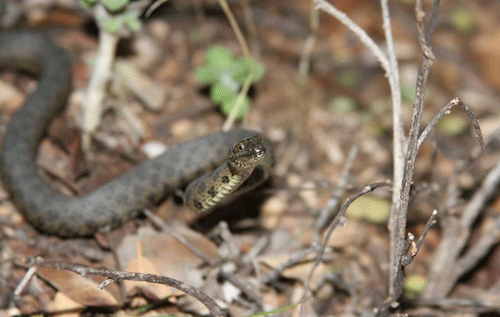CRL: Conservation Projects - Ecology and Behavior
Effect of personality on the exploration and settlement stages of natal dispersal
-
Time Period: August 2012 - Present
-
Student: Allyssa L. Kilanowski
-
Location: The Pinaleño Mountains, AZ, U.S.A.
-
 Major Questions: I am interested in factors affecting natal dispersal, the movement of organisms away from their birthplace, and habitat selection. Three stages of dispersal are recognized: 1) emigration, 2) exploration and travel, and 3) settlement. The first stage of dispersal is well documented however, the second and third stages require more research as knowledge of these stages is critical to understanding the fitness consequences of dispersal.
The second phase of dispersal, exploration and travel, can be influenced by behavioral phenotypes, also called personalities. Theory and some empirical work demonstrate that personalities affect the distance that an animal disperses and the search strategy that an animal uses during dispersal to choose a settlement location. Animals appear to search for new habitats using three methods: 1.) threshold method (T), where an animal sequentially samples potential settlement locals without revisiting sites until one exceeding an individual’s threshold quality is reached, 2.) best of n (BN), where an animal sequentially samples potential settlement locals without revisiting sites, and chooses to settle one of the sampled areas, and 3.) comparative Bayes method (CB), where animals sample potential settlement locals multiple times with the possibility of revisits, before selecting a location to settle.
The third phase of dispersal, settlement, may be influenced by natal environmental experience and personality. The natal habitat preference induction (NHPI) hypothesis states that animals will choose to settle in an area that is similar to their
Major Questions: I am interested in factors affecting natal dispersal, the movement of organisms away from their birthplace, and habitat selection. Three stages of dispersal are recognized: 1) emigration, 2) exploration and travel, and 3) settlement. The first stage of dispersal is well documented however, the second and third stages require more research as knowledge of these stages is critical to understanding the fitness consequences of dispersal.
The second phase of dispersal, exploration and travel, can be influenced by behavioral phenotypes, also called personalities. Theory and some empirical work demonstrate that personalities affect the distance that an animal disperses and the search strategy that an animal uses during dispersal to choose a settlement location. Animals appear to search for new habitats using three methods: 1.) threshold method (T), where an animal sequentially samples potential settlement locals without revisiting sites until one exceeding an individual’s threshold quality is reached, 2.) best of n (BN), where an animal sequentially samples potential settlement locals without revisiting sites, and chooses to settle one of the sampled areas, and 3.) comparative Bayes method (CB), where animals sample potential settlement locals multiple times with the possibility of revisits, before selecting a location to settle.
The third phase of dispersal, settlement, may be influenced by natal environmental experience and personality. The natal habitat preference induction (NHPI) hypothesis states that animals will choose to settle in an area that is similar to their natal area, and predicts a mechanism that facilitates selection of suitable habitat for settlement. NHPI has been studied in a variety of taxa including mice, squirrels, birds, and fish. It may be adaptive, as habitat that produces individuals old enough to disperse is most likely habitat of reasonable quality, thus individuals should use cues from the natal area to help reduce search time and increase fitness. I am addressing several questions that involve natal dispersal, juvenile habitat selection, individual personality, and decision-making rules using cliff chipmunks (Tamias dorsalis) as a model system.
natal area, and predicts a mechanism that facilitates selection of suitable habitat for settlement. NHPI has been studied in a variety of taxa including mice, squirrels, birds, and fish. It may be adaptive, as habitat that produces individuals old enough to disperse is most likely habitat of reasonable quality, thus individuals should use cues from the natal area to help reduce search time and increase fitness. I am addressing several questions that involve natal dispersal, juvenile habitat selection, individual personality, and decision-making rules using cliff chipmunks (Tamias dorsalis) as a model system. -
Research Questions: Can an animal’s personality explain the search method (T, BN, or CB) used for selecting a new habitat? Does an animal’s personality affect natal dispersal distance? Do dispersing juveniles settle in habitat similar to their natal habitat (NHPI)?
Project Details (click to expand/reduce)
Occurrence and habitat use by Big Cypress fox squirrels on public lands
-
Time Period:August 2016 - May 2021
-
PhD student: Kira Hefty
-
Location: Southwest Florida, U.S.A.
Project Details (click to expand/reduce)
Project Description & Bio:
 In Florida, native wildlife species face multiple threats including human development, habitat fragmentation, fire suppression, invasive species, and changes in the hydrologic regime. One of the greatest challenges to conserving species in this unique environment is a general lack of knowledge of species-specific habitat requirements and movement behavior. Big Cypress fox squirrels (Sciurus niger avicennia) are an endemic subspecies of fox squirrel in southwest Florida. Because so little is currently known about its extent of occurrence and landscape-level habitat requirements, S. n. avicennia has been declined listing as a federally protected species. Most studies involving this charismatic subspecies have been conducted in urban environments rather than in their natural habitat. In 2012, Big Cypress fox squirrels were named as a Species of Greatest Conservation Concern in Florida’s Wildlife Legacy Initiative Wildlife Action Plan. Kira will be working on public lands with multiple federal and state agencies to decrease knowledge gaps concerning this unique subspecies and provide science-based conservation and management recommendations. Kira is also interested in connecting with community members and establishing long-term outreach programs that will facilitate local interest in conserving Florida’s delicate and special ecosystems.
In Florida, native wildlife species face multiple threats including human development, habitat fragmentation, fire suppression, invasive species, and changes in the hydrologic regime. One of the greatest challenges to conserving species in this unique environment is a general lack of knowledge of species-specific habitat requirements and movement behavior. Big Cypress fox squirrels (Sciurus niger avicennia) are an endemic subspecies of fox squirrel in southwest Florida. Because so little is currently known about its extent of occurrence and landscape-level habitat requirements, S. n. avicennia has been declined listing as a federally protected species. Most studies involving this charismatic subspecies have been conducted in urban environments rather than in their natural habitat. In 2012, Big Cypress fox squirrels were named as a Species of Greatest Conservation Concern in Florida’s Wildlife Legacy Initiative Wildlife Action Plan. Kira will be working on public lands with multiple federal and state agencies to decrease knowledge gaps concerning this unique subspecies and provide science-based conservation and management recommendations. Kira is also interested in connecting with community members and establishing long-term outreach programs that will facilitate local interest in conserving Florida’s delicate and special ecosystems.
Research Questions:
1) What is the extent of occurrence of S. n. avicennia? 2) Which habitat features are associated with S. n. avicennia presence? 3) How has habitat degradation and fragmentation affected S. n. avicennia dispersal and movement patterns?
Big cypress fox squirrel - photo courtesy of John Kellam
Noninvasive conservation techniques for monitoring spatial ecology and habitat use: conservation of the threatened narrow-headed gartersnake, Thamnophis rufipunctatus
-
Time Period: 2016 - 2021
-
PhD student: Brian Blais
-
Location: Central Arizona (Mogollon Rim region)
Project Details (click to expand/reduce)
Project Description & Bio:

Understanding ecological dynamics of a species is paramount to uncover life history traits and adaptations to environmental stimuli. One such field is spatial ecology and habitat selection. By tracking animal movements, we gain insight into their resource requirements, movement dynamics, and home ranges. Moreover, radio telemetry techniques can also investigate social and reproductive behaviors, activity, and physiological tolerances. This is warranted for species reintroductions and conservation translocations, especially since a data void exists regarding the viability of reintroductions. The success of conservation-driven translocations is dependent on the subsequent survival and reproduction among that given population.
The narrow-headed gartersnake, Thamnophis rufipunctatus is a small, semi-aquatic snake endemic to lotic riparian areas of the Mogollon Rim region in Arizona and New Mexico. Due to population decline and habitat loss largely stemming from predation and competition by non-native species, T. rufipunctatus was listed as threatened in 2014. A multi-partnered conservation working group, including Arizona Game & Fish Department and U.S. Fish & Wildlife Service, joined to formulate T. rufipunctatus management and recovery objectives including: 1) establish a viable reintroduction program from an ex situ source; 2) identify biotic and abiotic characters associated with seasonal microhabitat usage; and 3) characterize terrestrial behavior to better inform potential conservation measures regarding projects in occupied habitat.
My interests are broad but generally focus on wildlife conservation, especially applied non-invasive techniques that address ecological questions. I work directly with the Arizona Center for Nature Conservation — Phoenix Zoo’s conservation department to address objective #1 and provide science-based conservation and management recommendations towards the recovery of narrow-headed gartersnakes. Working collaboratively on ways to facilitate ex situ management as a robust tool for species recovery can be applicable across a wide variety of taxa. Part of my research takes advantage of a unique opportunity to study behavioral, physiological, and life history traits at the ex situ level to better understand and systematically address conservation questions at the in situ level. In 2016, KCRL, the Phoenix Zoo, and management agencies conducted the first conservation translocation of zoo-propagated T. rufipunctatus into a site within its native range and devoid of non-native threats.
Currently, I use a non-invasive radio telemetry technique (see Wylie et al. 2011 Herpetological Review) and other tools to monitor gartersnake populations. Many of these novel techniques are applicable to other taxa for conservation purposes. I’m also interested in connecting with outreach programs to facilitate all-around interest in wildlife conservation and management. This includes genomic techniques (e.g., phylogeography, eDNA), road ecology, and citizen-science initiatives. Often, I address my interests with herpetofauna as they provide excellent models for conservation and ecology.
Major questions:
1) What is the spatial and behavioral ecology of T. rufipunctatus and which characters influence microhabitat selection? 2) What can we learn from ex situ management and how can it be a tool for maximizing viability of in situ conservation translocations? 3) Can novel, non-invasive techniques generate the same information as status quo techniques, especially for population monitoring?
Personal background:
Brian has a background in ecology, evolution, and wildlife management gained from a blend of academics and employments. Originally from Connecticut, Brian spent several years working for their state wildlife agency partaking in a plethora of field work including bat population monitoring, imperiled shorebird conservation, amphibian disease ecology, and public engagement. Brian has also been on the road with studies or jobs in the Midwest, Australian, and Peru. Following a lifelong passion, Brian acquired a MSc degree studying the genomic phylogeography of the smooth greensnake before making his way to the American Southwest. For fun, Brian enjoys cooking, traveling, and leaping out of cars to help turtles cross roads.
See more about my collaborative research endeavors here: https://www.researchgate.net/profile/Brian_Blais2


Current status, habitat use, and variables that influence human-bear conflict in Andean bears in Colombia
-
Time Period:August 2016 - May 2020
-
PhD student: Ivan Mauricio Vela-Vargas
-
Location: Chingaza National Natural Park, Colombia
Project Details (click to expand/reduce)
Project Description & Bio:
 Located in the northernmost Andes, Colombia has a unique combination of natural conditions as the Andes split into 3 ranges that results in a complex combination of ecosystems and great biodiversity. High Andean forests and Paramos are the most biodiverse ecosystems in the world, yet are also where most of the human population in Colombia live. These areas are also the main habitat for the most unique bear species, the Andean bear (Tremarctos ornatus).
Located in the northernmost Andes, Colombia has a unique combination of natural conditions as the Andes split into 3 ranges that results in a complex combination of ecosystems and great biodiversity. High Andean forests and Paramos are the most biodiverse ecosystems in the world, yet are also where most of the human population in Colombia live. These areas are also the main habitat for the most unique bear species, the Andean bear (Tremarctos ornatus).
Given the high degradation of most Andean ecosystems, the habitat and natural range of the Andean Bear has been severely fragmented and disturbed by human activities. Severe threats such as habitat loss, hunting, and human-bear conflicts are threats to the species across its distribution, and are especially relevant for the Chingaza massif, considered the most important stronghold for bear conservation in Colombia.
The loss of natural habitats and hunting pressure are especially evident in Chingaza Massif and its National Natural Park (Chingaza National Natural Park), where within the protected 76600 ha, Andean bear occupancy has increased 100% in the last few years, where > 33 individuals have been identified. As presence of bears increases and habitat declines, conflicts with human settlements increase concomitantly, mostly near park boundaries. Conflict often translates into retaliation hunting of bears, promoted by landscape features, management practices, and hunting.
My project is focused on three major questions that are: 1. Which is the real availability and the status of the natural habitats used by Andean bears in the Chingaza Massif and the east Cordillera of Colombia? 2. How do biotic and abiotic variables affect the movement and habitat use of Andean Bears in the Chingaza National Natural Park and its buffer zones? and 3. What variables are enhancing human – bear conflicts in the Chingaza Masiff.
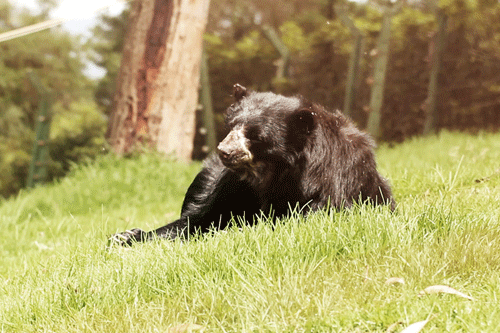
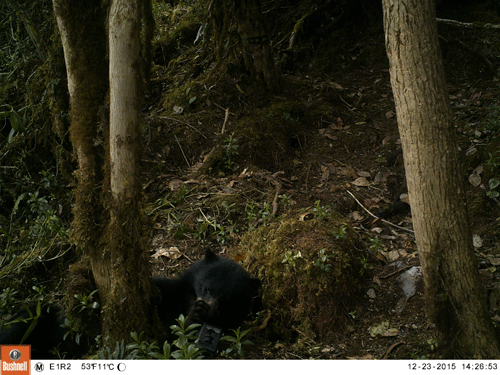
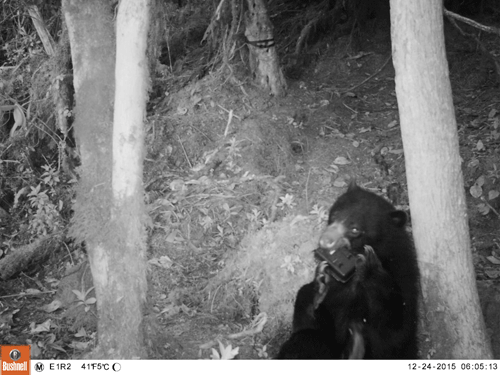
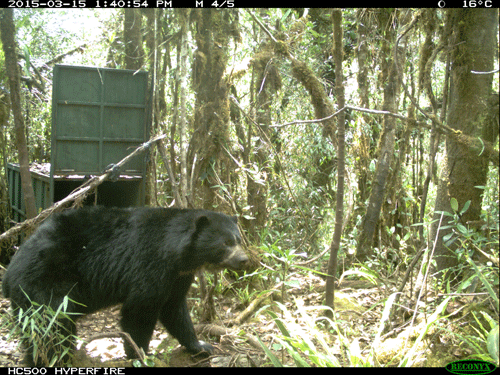
Major questions:
My project is focused on three major questions that are: 1. Which is the real availability and the status of the natural habitats used by Andean bears in the Chingaza Massif and the east Cordillera of Colombia? 2. How do biotic and abiotic variables affect the movement and habitat use of Andean Bears in the Chingaza National Natural Park and its buffer zones? and 3. What variables are enhancing human – bear conflicts in the Chingaza Masiff.
Personal background:
Mauricio has worked in mammalian ecology and reproductive biology in agricultural landscapes in Colombia. His experience is focused on the effect of agricultural landscapes in species and community ecology and in seeking strategies to improve landscape planning. He is part of the Colombian Mammalogy board.
 Located in the northernmost Andes, Colombia has a unique combination of natural conditions as the Andes split into 3 ranges that results in a complex combination of ecosystems and great biodiversity. High Andean forests and Paramos are the most biodiverse ecosystems in the world, yet are also where most of the human population in Colombia live. These areas are also the main habitat for the most unique bear species, the Andean bear (Tremarctos ornatus).
Located in the northernmost Andes, Colombia has a unique combination of natural conditions as the Andes split into 3 ranges that results in a complex combination of ecosystems and great biodiversity. High Andean forests and Paramos are the most biodiverse ecosystems in the world, yet are also where most of the human population in Colombia live. These areas are also the main habitat for the most unique bear species, the Andean bear (Tremarctos ornatus).Given the high degradation of most Andean ecosystems, the habitat and natural range of the Andean Bear has been severely fragmented and disturbed by human activities. Severe threats such as habitat loss, hunting, and human-bear conflicts are threats to the species across its distribution, and are especially relevant for the Chingaza massif, considered the most important stronghold for bear conservation in Colombia.
The loss of natural habitats and hunting pressure are especially evident in Chingaza Massif and its National Natural Park (Chingaza National Natural Park), where within the protected 76600 ha, Andean bear occupancy has increased 100% in the last few years, where > 33 individuals have been identified. As presence of bears increases and habitat declines, conflicts with human settlements increase concomitantly, mostly near park boundaries. Conflict often translates into retaliation hunting of bears, promoted by landscape features, management practices, and hunting.




Major questions:
My project is focused on three major questions that are: 1. Which is the real availability and the status of the natural habitats used by Andean bears in the Chingaza Massif and the east Cordillera of Colombia? 2. How do biotic and abiotic variables affect the movement and habitat use of Andean Bears in the Chingaza National Natural Park and its buffer zones? and 3. What variables are enhancing human – bear conflicts in the Chingaza Masiff.
Personal background:
Mauricio has worked in mammalian ecology and reproductive biology in agricultural landscapes in Colombia. His experience is focused on the effect of agricultural landscapes in species and community ecology and in seeking strategies to improve landscape planning. He is part of the Colombian Mammalogy board.
Conservation of the freshwater rivers of Nepal: Endangered dolphins as indicators of river system health
-
Time Period: January 2017 - December 2019
-
PhD student: Shambhu Paudel
-
Location: Nepal (Karnali, Sapta Koshi, and Narayani river systems)
-
How can survey techniques to provide robust estimates of abundance for Ganges river dolphin in Nepalese river systems be improved?
-
How do underwater behaviors and diel activity patterns of Ganges river dolphins change spatially and temporarily?
-
How do artisanal fishing communities affect the habitat use of Ganges river dolphins?
-
Is currently available natural water flow (discharge) sufficient to conserve Ganges river dolphins in Nepalese waterways during the low water season?
-
Is there a taxonomic and phylogenic relationship between isolated groups of Ganges River dolphins?
-
Russell E. Train Fellow (World Wildlife Fund-USA) for Freshwater Conservation in Nepal
-
Officially affiliated with Institute of Forestry, Tribhuwan University in Nepal as assistant professor
-
Worked for freshwater river conservation in Nepal focusing river dolphin and other similar texa like Gharial to improve freshwater species conservation efforts
-
Aim to deliver and assist Government of Nepal to prepare “Dolphin recovery action plan” after the completion of PhD project
-
Time Period:Fall 2016 -Present
-
PHD student: Stuart Wells
-
Location: The Phoenix Zoo and Pinaleño Mountains AZ, U.S.A.
-
 Project Description & Bio:
Project Description & Bio: -
I have always been drawn to science, in particular to science-based questions such as how and why. I am particularly interested in applying information gained from scientific exploration directly towards understanding how species function in ecological systems and developing or improving how we manage animals within those systems. The field of conservation biology lends itself to these direct inquiries of how and why especially towards understanding how to manage ex situ animals destined for reintroduction. Effective species conservation is of crucial importance because the anthropogenic activities prevalent in the world today negatively impact nearly every aspect of the natural world. The effect of these activities on species abundance and biodiversity is either direct as a result of harvesting or exploitation, such as over-hunting and illegal trade of animals, or indirect as a result of environmental and ecological changes, such as climate change and watershed manipulation. These intrusions ultimately cause species declines, and can lead to local extirpation, or without managed intervention, species extinction. Consequently, developing an understanding of how to manage animals ex situ to maximize the likelihood of their survival when introduced into the wild is a promising tool for enhancing species conservation programs. The pilot propagation and release program for Mt. Graham red squirrel (Tamiasciurus fremonti grahamensis) is an example of one such effort. This subspecies was listed as critically endangered in 1987, due to drastic population decline caused by forest wildfire and subsequent disease that severely impacted its habitat and resource availability. Although studied extensively in the wild, the Mt. Graham red squirrel has yet to reproduce in an ex situ setting, placing importance on developing an efficient propagation and release program, coupled with an active habitat improvement program, as an essential component of the conservation of this species.
-
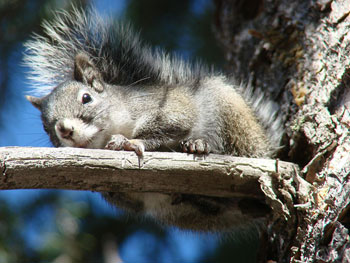
-
Due to the imperiled nature of T. f. grahamensis, the future survival of this species may rely on augmentation of ex situ propagated individuals to replenish the wild population. Much is known about the habitat preferences, foraging requirements, and social structure of Mount Graham red squirrels in the wild (Brown 1984, Sanderson 2009, Steele 1998.) Both sexes are solitary and have are extremely territorial (Sanderson and Koprowski 2009.) They are larder hoarders and maintain a “midden” that also serves to demarcate their territory (Sanderson and Koprowski 2009.) Intense territorial aggression is relaxed during the breeding season when males seek out receptive females to breed. It is believed that the female estrus cycles occur only one per breeding season (Steele 1998), and female receptivity is thought only to occur within a four or six-hour window (USFWS 2015.) Although the Mount Graham red squirrels have been held ex situ successfully (Wells, 2012), ex situ reproduction has not yet occurred. My research will use known hormone markers to ascertain and validate physiological patterns indicative of estrus, and by examining the associated male to female behavioral responses. Behavior-physiological information will then be used to develop management techniques to determine when to introduce pairs for breeding while minimizing the likelihood of injury, or estrus disruption due to aggression. Finally, I will also investigate optimal methods for ex situ rearing to maximize survival of individual squirrel translocated to in situ by attempting to create ex situ rearing conditions indicative of ideal habitat, or by mimicking natal dispersal cues (Merrick and Koprowski, 2016.)
-
Time Period: August 2016 -Present
-
Master's student: Colin Brocka
-
Location: San Rafael Valley, Santa Cruz and Cochise counties, Arizona, U.S.A.
-
Project Description & Bio:
-
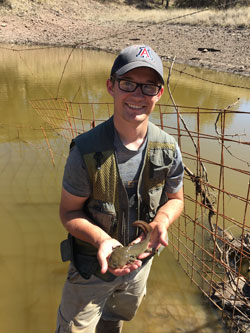 The Sonoran tiger salamander (Ambystoma mavortium stebbinsi) is a subspecies of tiger salamander endemic to the San Rafael Valley (SRV) of southeastern Arizona. Historically, this species bred in naturally occurring ponds and springs, but arroyo cutting (the formation of deep, steep-sided, ravines by ephemeral waterways) and erosion in the area has caused most of the SRV to lose natural surface water. Cattle tanks created by ranchers have taken the place of natural springs and are now primary breeding sites for salamanders. Larvae can develop into either gilled aquatic adults called paedomorphs, or undergo metamorphosis into terrestrial salamanders without gills. The subspecies was listed as endangered in 1997 due to its highly restricted distribution, dependence on human-constructed environments, breeding site invasion by non-native fish and/or bullfrogs, and risk of frequent die-offs due to disease.
The ecology of Sonoran Tiger Salamanders outside of breeding ponds, and their dispersal patterns are largely unknown. The terrestrial metamorph is the only life stage capable of re-populating cattle tanks that lose salamanders due to drying or disease, and thus this stage is critical to conservation and maintenance of metapopulation dynamics. Through the use of radio-telemetry and habitat measurements, this study will provide information on the spatial ecology and life history of the terrestrial morph, and facilitate the development of well-informed management practices needed to conserve this species.
The Sonoran tiger salamander (Ambystoma mavortium stebbinsi) is a subspecies of tiger salamander endemic to the San Rafael Valley (SRV) of southeastern Arizona. Historically, this species bred in naturally occurring ponds and springs, but arroyo cutting (the formation of deep, steep-sided, ravines by ephemeral waterways) and erosion in the area has caused most of the SRV to lose natural surface water. Cattle tanks created by ranchers have taken the place of natural springs and are now primary breeding sites for salamanders. Larvae can develop into either gilled aquatic adults called paedomorphs, or undergo metamorphosis into terrestrial salamanders without gills. The subspecies was listed as endangered in 1997 due to its highly restricted distribution, dependence on human-constructed environments, breeding site invasion by non-native fish and/or bullfrogs, and risk of frequent die-offs due to disease.
The ecology of Sonoran Tiger Salamanders outside of breeding ponds, and their dispersal patterns are largely unknown. The terrestrial metamorph is the only life stage capable of re-populating cattle tanks that lose salamanders due to drying or disease, and thus this stage is critical to conservation and maintenance of metapopulation dynamics. Through the use of radio-telemetry and habitat measurements, this study will provide information on the spatial ecology and life history of the terrestrial morph, and facilitate the development of well-informed management practices needed to conserve this species. -
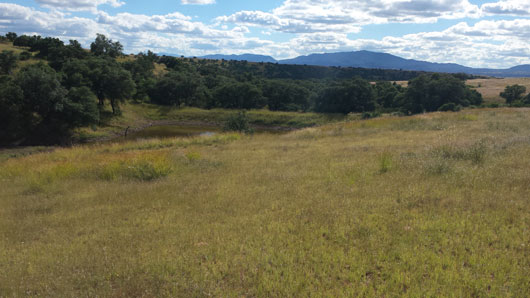
Major Questions:
1. How does the Sonoran tiger salamander move in its terrestrial habitat?
2. What habitat characteristics and refuge types do terrestrial Sonoran Tiger Salamanders use?
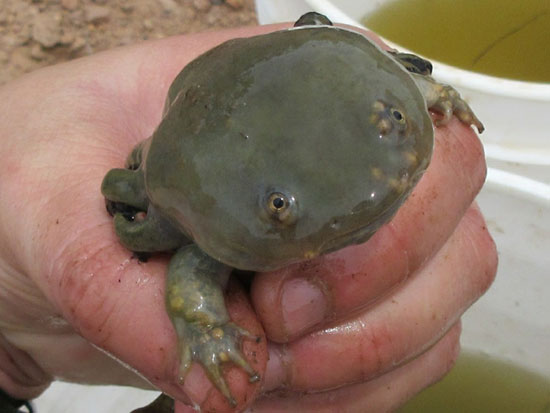
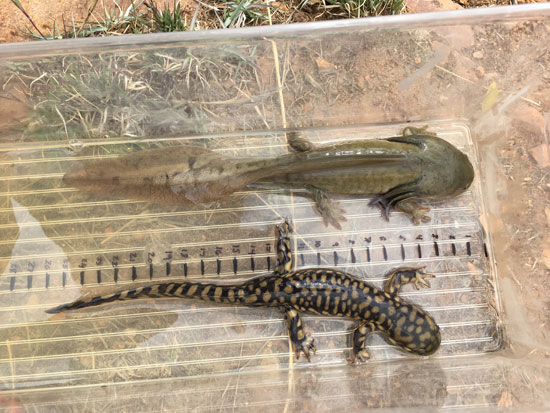
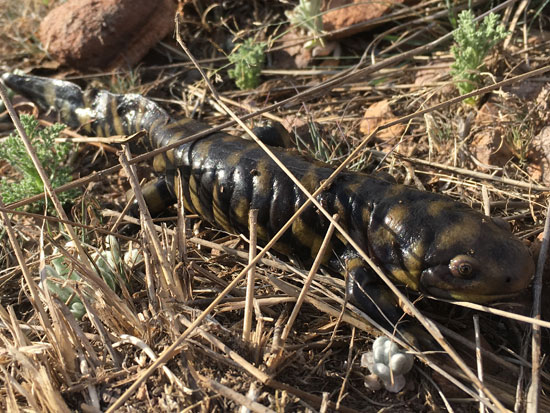
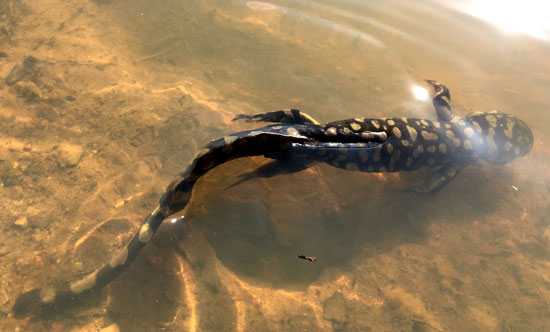
-
PhD student:Marina Morandini
-
Location: Pinaleño Mountains, Arizona, U.S.A.
-
Project Description & Bio:
-
 I am interested in which factors can regulate or limit population abundance. No population increases without limit, but understanding the factors that prevent this phenomenon is not easy. There are intrinsic and extrinsic factors that influence population size. Extrinsic factors influence populations by actions of other species, such as predators or competitors, and by physical-chemical factors such as climate or nutrient supplies. Intrinsic factors instead are internal to the population, such as sex, age, behavior and genetic traits. Understanding which factors could affect population dynamics of a particular animal or plant is the core of conservation, land management, fisheries and pest control and are crucial to developing specific management plans for individual species.
I am interested in which factors can regulate or limit population abundance. No population increases without limit, but understanding the factors that prevent this phenomenon is not easy. There are intrinsic and extrinsic factors that influence population size. Extrinsic factors influence populations by actions of other species, such as predators or competitors, and by physical-chemical factors such as climate or nutrient supplies. Intrinsic factors instead are internal to the population, such as sex, age, behavior and genetic traits. Understanding which factors could affect population dynamics of a particular animal or plant is the core of conservation, land management, fisheries and pest control and are crucial to developing specific management plans for individual species.
-
Research questions:
Despite more than fifteen years of legal protection, Mt Graham Red Squirrel population plummeted after a peak of 562 squirrels in 1999 to approximately 250 individuals in the recent years. Why is the population abundance not increasing? Are food resources a limited factor for this population? Can artificial midden help the settlement of squirrels during dispersal? Is there a high predator pressure on the squirrel population on Mt. Graham? Is it possible that parasites play a role in the regulation of this population? -
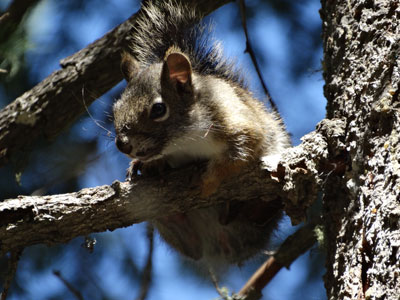
Personal background:
I completed my master’s degree in Italy where I studied the competition between the European Red Squirrel (Sciurus vulgaris) and the invasive species Pallas’s squirrels (Callosciurus erythraeus), whose native range is in southeast Asia. In particular I analyzed the competition for food and space, using telemetry and live-trapping.
I worked The University of Milan to control the invasive population of the Grey Squirrel near Milan.I volunteered for six months for Kluane Red Squirrel project (Yukon, Canada) where I worked to collect data on populations dynamics of red squirrel and snowshoe hare.
-
Master's student:Neil Dutt
-
Location: Pinaleño Mountains, Arizona, U.S.A.
-
Project Description & Bio:
-
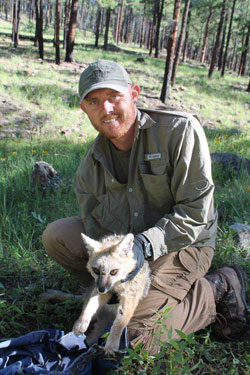 Populations that exist on the periphery of the species’ are living on the extreme limits of that species’ habitat tolerances relative to the core population. Studying the populations on the periphery of their range can provide insight into how that species, as a whole, may react in the face of climate change.
Populations that exist on the periphery of the species’ are living on the extreme limits of that species’ habitat tolerances relative to the core population. Studying the populations on the periphery of their range can provide insight into how that species, as a whole, may react in the face of climate change.
Long-tailed voles (Microtus longicaudus) are an abundant and wide ranging species of rodents in North America. This species ranges from Alaska to the sky islands of New Mexico and Arizona. These voles have been lightly studied in the northern part of their range in Alaska, Canada, and the Pacific Northwest, however, there are few studies on long-tailed voles in the southern extent of their range. The white-bellied vole (M. l. leucophaeus), a sub-species of the long-tailed vole, is endemic to the Pinaleño Mountains in southwestern Arizona. This population represents the southernmost extension of this species. The location and isolation of this population presents an exciting opportunity to learn more about how northern species may react to the changes brought about by climate change.Research questions:
In this study I aim to evaluate differences in the demography, social characteristics, and habitat selection of the isolated fringe population of long tailed voles, in the Pinaleño Mountains, in comparison to the northern core population.
Watch a video of a white-bellied vole
-
Time Period: November 2015 - November 2016
-
Master's student: Allie Burnett
-
Location: Santa Rita Experimental Range, Pima County AZ, U.S.A.
-

Background: Communication plays a monumental role in ecological interactions, functioning as a way to share information through signal variation. A majority of recent research has focused on the role of sociality in selecting for communication with multiple layers of variability, or communicative complexity. As social complexity increases, the need to communicate information to multiple individuals in a variety of contexts also increases. In support of this hypothesis, comparative analyses in ground-dwelling sciurids have shown that species exhibiting high social complexity do indeed exhibit high communicative complexity in alarm calling systems. These relationships, however, are less clearly defined in species of low to moderate sociality and there is some indication that other factors influence alarm call complexity. If some level of communicative complexity is found in a species of low sociality, it will serve as evidence that signal flexibility can precede and potentially initiate social evolution. By examining which, if any, elements of communicative complexity are maintained in an asocial species, it is possible to discern the importance of other causal factors, such as predation pressure, in the evolution of communicative complexity. Ammospermophilus harrisii is a small, diurnal ground squirrel that lives in low population densities. Offspring disperse soon after emergence above ground and because adults do not hibernate, individuals are solitary for a majority of the year. According to the sociality hypothesis, this species should exhibit little to no communicative complexity. Despite this, there is evidence of two types of calls given when disturbed, a surprising layer of complexity for an asocial animal that spends much of its life in solitude.
I will be focusing on a population within the Santa Rita Experimental Range that occupies a transition zone between desert scrubland and grassland and has experienced extensive mesquite encroachment over the past century. By documenting differences in vegetation density among territories, I will assess potential effects of vegetation density on anti-predatory behavior and signal degradation. This has broad implications regarding the impacts of woody encroachment on predator-prey dynamics and communication in arid lands. The results of this study may be used to inform conservation strategies for threatened and endangered grassland species.
Research questions: 1) What is the function of these different alarm call types? 2) Does sociality play a role in selection for different call types in this population? 3) What other factors might contribute to this signal variation? To answer these questions, I will be eliciting anti-predatory behavior in A. harrisii via simulated predator introductions and comparing response behavior and acoustical characteristics across different social and predatory contexts.
-
Time Period: May 2013-Present
-
Student: Maria Altemus
-
Location: Southeastern Arizona, U.S.A.
-
 Major Questions: The antelope jackrabbit (Lepus alleni) is a large hare found in southern Arizona south into Mexico that has not been intensely studied and about which little is known. Early studies on antelope jackrabbits were conducted in the 1930’s, in relation to cattle grazing, but since then, very little has been published about these secretive and fast animals. Antelope jackrabbits are so called because their white rump is displayed when they flee, similar to the pronghorn (Antilocapra americana). These animals inhabit the shrubby grasslands that span the U.S.-Mexico border. They are uniquely adapted to their desert environment, as they do not require free water to survive, but instead rely on their food sources (such as mesquite and succulents) and physiological specializations to persist. One food that these animals eat is the fruit of the Pima pineapple cactus (Coryphantha scheeri var. robustispina).
Major Questions: The antelope jackrabbit (Lepus alleni) is a large hare found in southern Arizona south into Mexico that has not been intensely studied and about which little is known. Early studies on antelope jackrabbits were conducted in the 1930’s, in relation to cattle grazing, but since then, very little has been published about these secretive and fast animals. Antelope jackrabbits are so called because their white rump is displayed when they flee, similar to the pronghorn (Antilocapra americana). These animals inhabit the shrubby grasslands that span the U.S.-Mexico border. They are uniquely adapted to their desert environment, as they do not require free water to survive, but instead rely on their food sources (such as mesquite and succulents) and physiological specializations to persist. One food that these animals eat is the fruit of the Pima pineapple cactus (Coryphantha scheeri var. robustispina). 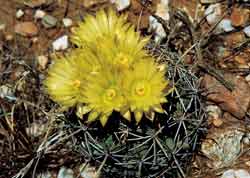 This cactus is listed as endangered by the U.S. Fish and Wildlife Service as endangered and it is therefore important to learn about the ecology of this plant as well as the animals that depend on it.
This cactus is listed as endangered by the U.S. Fish and Wildlife Service as endangered and it is therefore important to learn about the ecology of this plant as well as the animals that depend on it. -
Through my research, I am hoping to examine more closely at the social structure and behavior of antelope jackrabbits, as they are sometimes seen in groups of up to 5 or 6. I also hope to place radio or GPS collars on animals, as this has never been done, and learn more about habitat use and territoriality. This aspect of my research will tie in with antelope jackrabbit’s use of Pima pineapple cactus and their role in the seed dispersal of this endangered cactus.
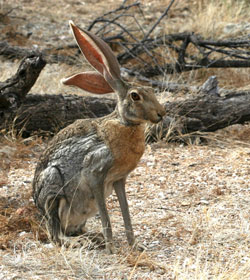
-
Major Findings: NA-Research in Progress
-
Time Period: January 2011-Present
-
Student: Sarah Hale
-
Location: Las Cienegas National Conservation Area, AZ, U.S.A
-
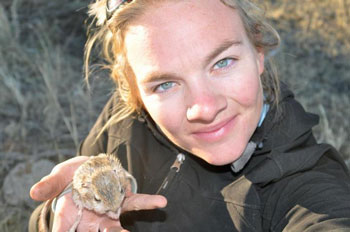 The loss of biodiversity can have profound effects on an ecosystem, especially when a species lost is important to that ecosystem. The keystone species concept was introduced over 40 years ago, by Paine, referring to the role of the starfish Pisaster ochraceus and tritons Charonia spp. in the marine littoral zone (Paine 1969, Mills et al. 1993). A keystone species is exceptionally important in maintaining the organization and diversity of their community (Mills et al. 1993), and has been defined as a species whose impact on its community or ecosystem is large, and disproportionately large relative to its abundance (Power et al. 1996).
The loss of biodiversity can have profound effects on an ecosystem, especially when a species lost is important to that ecosystem. The keystone species concept was introduced over 40 years ago, by Paine, referring to the role of the starfish Pisaster ochraceus and tritons Charonia spp. in the marine littoral zone (Paine 1969, Mills et al. 1993). A keystone species is exceptionally important in maintaining the organization and diversity of their community (Mills et al. 1993), and has been defined as a species whose impact on its community or ecosystem is large, and disproportionately large relative to its abundance (Power et al. 1996). -
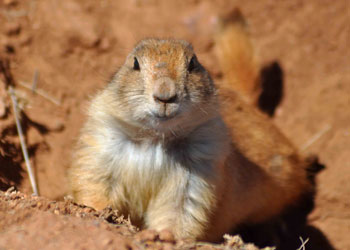 The black-tailed prairie dog (BTPD: Cynomys ludovicianus) is considered
The black-tailed prairie dog (BTPD: Cynomys ludovicianus) is considered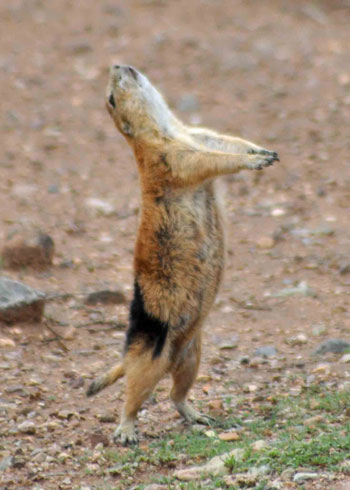 a keystone species, and was extirpated by humans from its historical range in Arizona by 1960. The BTPD is seen as a pest by many people, but these ecosystem engineers provide burrows for other species (e.g. burrowing owls [Athene cunicularia] and rattlesnakes [Crotalus sp.]), excavate nutrient rich soil that, in turn, provides rich vegetation for grazers, and serve as a food source for many carnivores and birds of prey. Between 2008 and 2011 Arizona Game and Fish Department translocated approximately 380 BTPDs from New Mexico and Sonora to 3 sites at Las Cienegas National Conservation Area in southeastern Arizona to improve grassland health and increase species diversity within the BTPDs’ historical range. In 2012 a fourth site was populated with prairie dogs from Las Cienegas.
a keystone species, and was extirpated by humans from its historical range in Arizona by 1960. The BTPD is seen as a pest by many people, but these ecosystem engineers provide burrows for other species (e.g. burrowing owls [Athene cunicularia] and rattlesnakes [Crotalus sp.]), excavate nutrient rich soil that, in turn, provides rich vegetation for grazers, and serve as a food source for many carnivores and birds of prey. Between 2008 and 2011 Arizona Game and Fish Department translocated approximately 380 BTPDs from New Mexico and Sonora to 3 sites at Las Cienegas National Conservation Area in southeastern Arizona to improve grassland health and increase species diversity within the BTPDs’ historical range. In 2012 a fourth site was populated with prairie dogs from Las Cienegas. -
Research Questions: 1) Why do colonies exhibit the survival and reproductive rates observed? 2) What is the fate of dispersers, and why do certain individuals disperse from colonies? 3) Do translocated BTPDs establish a role as a keystone species? My results will provide important information for future management decisions, reduce human-prairie dog conflicts by documenting the impacts of their presence, assess their keystone species status, and provide information about where to introduce new colonies.
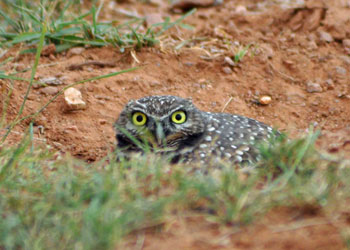
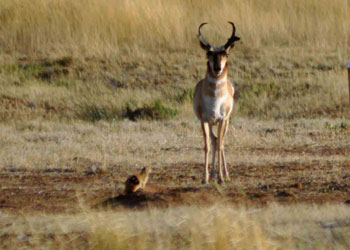

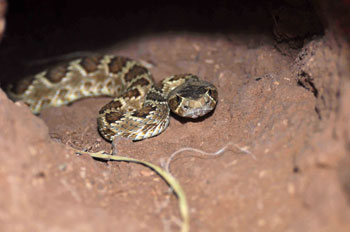
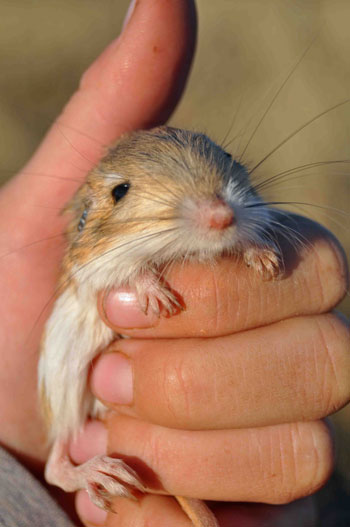
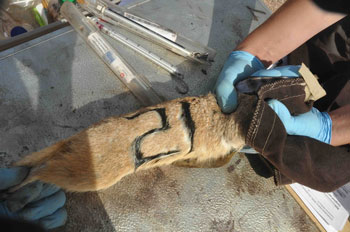

-
Time Period: August 2010-Present
-
Student: Erin Posthumus
-
Location: Mt. Graham, AZ, U.S.A.
-
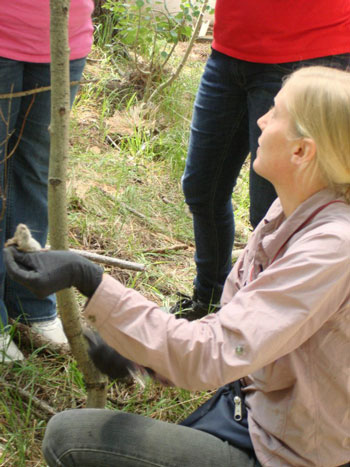 Red squirrels create structures, called middens, that concentrate food resources and create structural complexity in the forest, and some studies have found certain wildlife species to be associated with these middens. What is unclear is which characteristics of these middens attract species. My research will attempt to show which midden characteristics are most valuable to species diversity, which will have implications for forest management practices. My study will also shed light on the importance of larderhoarding animals to species diversity.
Red squirrels create structures, called middens, that concentrate food resources and create structural complexity in the forest, and some studies have found certain wildlife species to be associated with these middens. What is unclear is which characteristics of these middens attract species. My research will attempt to show which midden characteristics are most valuable to species diversity, which will have implications for forest management practices. My study will also shed light on the importance of larderhoarding animals to species diversity. -
Major Questions: Does species diversity differ at occupied middens, unoccupied middens and random locations? What characteristics of middens (i.e. vegetation features, food resources, and midden structure) affect species diversity? What is the importance of midden microclimate in explaining diversity?
-
Major Findings: Research in Progress
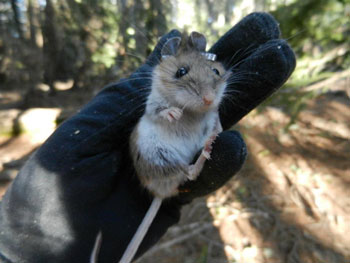
-
Time period: August 2010 – present
-
Student: Jonathan J. Derbridge
-
Location: Pinaleño Mountains, Arizona, USA
-
 Major Questions: I am studying mechanisms of competition between native and introduced species. Exploitation competition occurs when individuals have indirect negative effects on other individuals by restricting access to a common resource. Competition from introduced species for common food resources may force native species to forage more widely, and consume sub-optimal diets. Isolated populations of territorial species may, over time, become less adept at excluding ecologically similar competitors. I am using experimental removals of introduced Abert’s squirrels (Sciurus aberti) to test hypotheses on the impacts of dietary and spatial overlap with the Mount Graham red squirrel (Tamiasciurus hudsonicus grahamensis). I am also conducting tests of exploitation competition that relate to the relative abilities of an invader to succeed, and a native species to maintain its advantage. These tests include examining how Abert’s squirrels may take advantage of larder-hoarding by red squirrels, and comparing territorial behavior of Mount Graham red squirrels with individuals in other red squirrel populations.
Major Questions: I am studying mechanisms of competition between native and introduced species. Exploitation competition occurs when individuals have indirect negative effects on other individuals by restricting access to a common resource. Competition from introduced species for common food resources may force native species to forage more widely, and consume sub-optimal diets. Isolated populations of territorial species may, over time, become less adept at excluding ecologically similar competitors. I am using experimental removals of introduced Abert’s squirrels (Sciurus aberti) to test hypotheses on the impacts of dietary and spatial overlap with the Mount Graham red squirrel (Tamiasciurus hudsonicus grahamensis). I am also conducting tests of exploitation competition that relate to the relative abilities of an invader to succeed, and a native species to maintain its advantage. These tests include examining how Abert’s squirrels may take advantage of larder-hoarding by red squirrels, and comparing territorial behavior of Mount Graham red squirrels with individuals in other red squirrel populations. 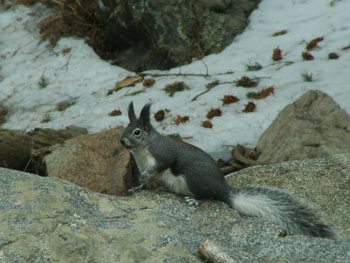
-
Research Questions: What are the impacts of dietary overlap between native and introduced species occupying similar niches? Does syntopy with an introduced species incur fitness costs associated with changes in home range size and composition for native species? Do introduced non-hoarding species compete with larder-hoarding native species through kleptoparasitism? Does isolation from interspecific competition lead to weakening of territorial behavior and facilitate successful invasions?
-
Time Period: May 2010 - Present
-
Student: Melissa Merrick
-
Location: The Pinaleño Mountains, AZ, U.S.A.
-
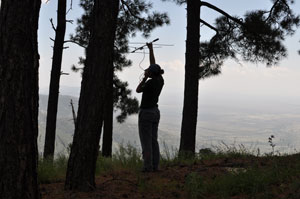 Major Questions: I am interested in factors influencing animal movements and habitat selection in the face of landscape alteration and fragmentation. Movement via natal dispersal is an important ecological mechanism contributing to gene flow, population structure and population dynamics, and guards populations against local extinction. Natal dispersal includes three stages: emigration, transience and exploration, and immigration and settlement. Whether an individual disperses, if it disperses how far it travels, how many places it explores, and where it settles is highly variable and is conditioned upon many factors including individual condition, local population density, sex ratios, resource abundance, experience in the natal area, habitat fragmentation, and individual behavior differences. Previous studies have shown that experience in the natal area provides individuals with important habitat cues which aid in deciding upon where to settle and also leads to variation in settlement patterns. Individual behavior differences may play a role in
Major Questions: I am interested in factors influencing animal movements and habitat selection in the face of landscape alteration and fragmentation. Movement via natal dispersal is an important ecological mechanism contributing to gene flow, population structure and population dynamics, and guards populations against local extinction. Natal dispersal includes three stages: emigration, transience and exploration, and immigration and settlement. Whether an individual disperses, if it disperses how far it travels, how many places it explores, and where it settles is highly variable and is conditioned upon many factors including individual condition, local population density, sex ratios, resource abundance, experience in the natal area, habitat fragmentation, and individual behavior differences. Previous studies have shown that experience in the natal area provides individuals with important habitat cues which aid in deciding upon where to settle and also leads to variation in settlement patterns. Individual behavior differences may play a role in dispersal distance and settlement decisions, including decision rules individuals employ when selecting a place to settle. Local density of conspecifics and associated sex ratios may influence male settlement decisions, whereas female settlement decisions may be more driven by available food resources. Increasingly, habitat fragmentation is also becoming an external factor influencing dispersal decisions and evidence suggests that small mammals dispersing through a fragmented habitat matrix tend to disperse further and explore less than individuals in contiguous habitat. I am testing several hypotheses related to natal habitat preference induction, behavioral phenotypes, decision rules, and habitat fragmentation and their influence on natal dispersal, especially transience and immigration.
dispersal distance and settlement decisions, including decision rules individuals employ when selecting a place to settle. Local density of conspecifics and associated sex ratios may influence male settlement decisions, whereas female settlement decisions may be more driven by available food resources. Increasingly, habitat fragmentation is also becoming an external factor influencing dispersal decisions and evidence suggests that small mammals dispersing through a fragmented habitat matrix tend to disperse further and explore less than individuals in contiguous habitat. I am testing several hypotheses related to natal habitat preference induction, behavioral phenotypes, decision rules, and habitat fragmentation and their influence on natal dispersal, especially transience and immigration. -
Some of my main research questions include: Do natal habitat cues (e.g. habitat structure, associated microclimate, and food availability) influence where settlement occurs? Do individual behavior differences (behavioral phenotypes) influence exploratory movements, decision rules, dispersal distance, and survival? Does forest fragmentation influence decision rules, settlement choices, and survivorship?
-
Major Findings To Date: Compared to non-peripheral red squirrel populations, dispersal in MGRS is sex-biased and exploration movements and settlement distances are far greater. Individual behavior differences explain variation in dispersal distances - active, aggressive individuals tend to disperse longer distances compared to less active, docile individuals. Natal habitat structure may play a role in cueing dispersers in on locations in which to settle. Forest structure derived from remotely sensed LiDAR data (e.g. canopy cover, basal area of live trees) in an individual’s natal area is more similar to forest structure at an individual’s settlement location compared to random locations. Further analyses are underway.
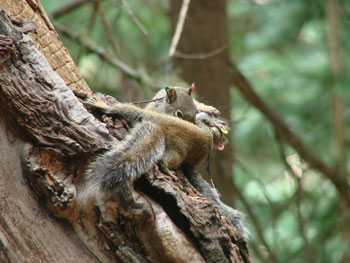
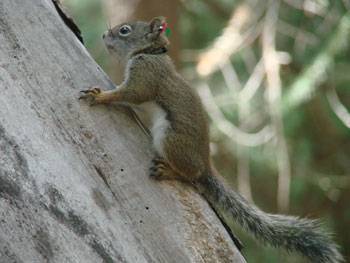
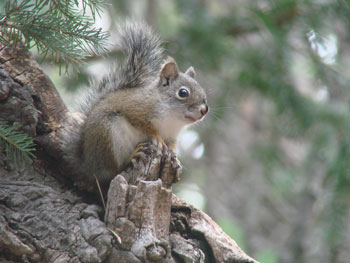
-
Time Period: 2009 - present
-
Student: Hsiang Ling Chen
-
Location: Mt. Graham, AZ, U.S.A.
-
 Road ecology is a burgeoning field of inquiry as roadways expand in number, length and width. We know that roads fragment habitats, increase mortality, change microclimates, and can act as barriers…thus they present a challenge in the conservation of biodiversity. Roads may function as impermeable barriers to some species while being semi-permeable to others. We are examining the relative permeability of roads to two species in the Pinaleno Mountains of southeastern Arizona: federally endangered Mt. Graham red squirrels (Tamiasciurus hudsonicus grahamensis) and non-native Aberts squirrels (Sciurus aberti).
Road ecology is a burgeoning field of inquiry as roadways expand in number, length and width. We know that roads fragment habitats, increase mortality, change microclimates, and can act as barriers…thus they present a challenge in the conservation of biodiversity. Roads may function as impermeable barriers to some species while being semi-permeable to others. We are examining the relative permeability of roads to two species in the Pinaleno Mountains of southeastern Arizona: federally endangered Mt. Graham red squirrels (Tamiasciurus hudsonicus grahamensis) and non-native Aberts squirrels (Sciurus aberti). -
Major Questions: Do red squirrels avoid roads? If so, what factors are most influential to avoidance? Do they avoid forest edges created by roads, forest gaps, or traffic disturbances?
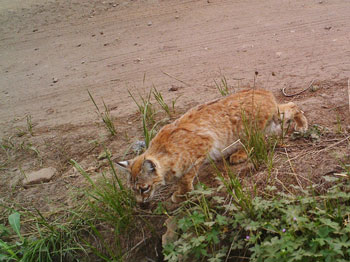
-
Time Period: 2009 - present
-
Student: Timothy G. Jessen
-
Location: Pinaleño (Graham) Mountains, Graham County, southeastern Arizona (Coronado National Forest).
-
 Major Questions/Objectives: Oftentimes ecological questions require information about what species occur within an area, where these species occur, and assessments of biodiversity. But species can provide challenges to sampling. Among small mammals, small size, inconspicuousness, and cryptic behavior lend to relative difficulty in sampling these species. Small mammals; however, are suffering increased rates of extinction and due to their intimate relationship with microhabitats, are thought to be significantly impacted by climate change, anthropogenic activity, and other environmental perturbations. Therefore accurate and reliable sampling techniques are paramount.
Major Questions/Objectives: Oftentimes ecological questions require information about what species occur within an area, where these species occur, and assessments of biodiversity. But species can provide challenges to sampling. Among small mammals, small size, inconspicuousness, and cryptic behavior lend to relative difficulty in sampling these species. Small mammals; however, are suffering increased rates of extinction and due to their intimate relationship with microhabitats, are thought to be significantly impacted by climate change, anthropogenic activity, and other environmental perturbations. Therefore accurate and reliable sampling techniques are paramount. -
A relatively novel method, known as hairtube sampling, offers great promise in sampling mammal (i.e. small mammal) species. Hairtube sampling is a non-invasive method for collecting mammal hair. Collected hair, when viewed under a microscope, has distinct features, thus permitting identification of unique species. Qualities of hairtube sampling include its non-invasive nature, extended sampling periods and larger sampling areas, potential to sample multiple species, and cost effectiveness. However, validation of the method is lacking. My research aims to rigorously test hairtube sampling and assess efficacy and utility of the method. My research will also produce a key for identifying mammal hair; providing a resource for future studies : How well do hairtubes detect species when presence is known? -Are hairtubes able to detect multiple species? -What are strengths/limitations of hairtube sampling, and what is best application(s) of the method?
-
Major Findings: Research still in progress; however, initial findings suggest hairtubes offer high probability of detecting species and ability to sample multiple species. Thus far, we have sampled and positively identified 10 species of mammals; ranging in size from cliff chipmunk (Tamias dorsalis) to black bear (Ursus americanus).
-
Time Period: May – July 2009 and June – July 2010
-
Student: Rosa Jessen
-
Location: Area de Conservacion Regional Tamshiyacu-Tahuayo, Loreto, Peru
-
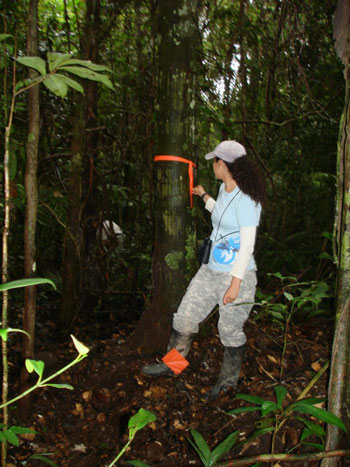 Major Questions: Does vegetation type affect density and habitat use of neotropical tree squirrels? What vegetation characteristics are influential to rainforest squirrels? What is the mammalian diversity associated with neotropical tree squirrels?
Major Questions: Does vegetation type affect density and habitat use of neotropical tree squirrels? What vegetation characteristics are influential to rainforest squirrels? What is the mammalian diversity associated with neotropical tree squirrels? -
Rainforests are home to the greatest mammal diversity, but little is known about most of the rainforest species. Small mammals in the rainforest play important roles, providing ecological services such as seed dispersal and pollination. These species also drive the dynamics and complexity of biological communities by serving as predators and providing a prey base for a range of rainforest species. The Amazon Basin contains one of the world’s largest rainforests, much of which is found in Peru. Five species of tree squirrels are found in the Peruvian Amazon: northern Amazon red squirrel (Sciurus igniventris), southern Amazon red squirrel (S. spadiceus), Bolivian squirrel (S. ignitus), Amazon dwarf squirrel (Microsciurus flaviventer) and neotropical pygmy squirrel (Sciurillus pusillus) but there is a great lack of knowledge of neotropical tree squirrels and no one has examined their role in rainforests. Little is known about life history, ecological interactions, and distribution of these squirrels.
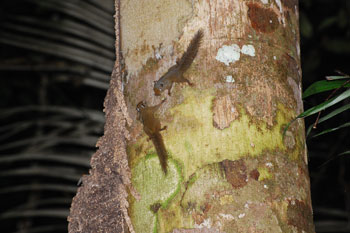
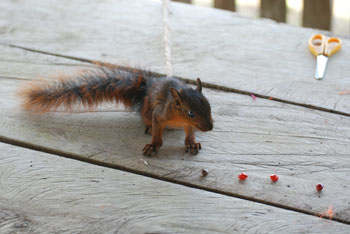
-
Time period: August 2006 – December 2009
-
Student: Nichole Cudworth
-
Location: Huachuca Mountains, Arizona, USA
-
Research questions: How does mating strategy influence the space use of Arizona gray squirrels? At what scale are Arizona gray squirrels selecting nest sites?
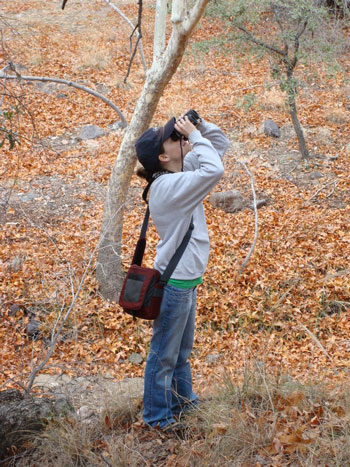
-
Major findings: Parental investment often differs between the sexes. For mammals, females invest heavily in reproduction, due to the high costs of pregnancy and lactation. Consequently, fitness of females is likely limited by the availability of food. Fitness of males, however, is more likely limited by the availability of mates. We investigated how these
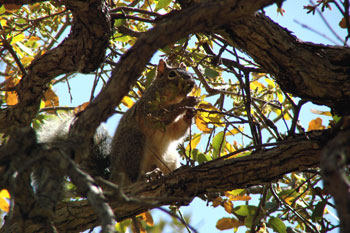 limiting factors would be predicted to influence the space use of Arizona gray squirrels. Arizona gray squirrels do not defend territories, and a female will only enter estrus for one day throughout the breeding season, thereby significantly reducing mating opportunities for males. We found that home ranges of Arizona gray squirrels are large (59 ha) and vary between sexes and seasons. Males had larger home ranges than females overall, and males increased home-range sizes during the breeding season, when males were traveling greater distances to locate receptive females. Females, however, maintained relatively constant home-range sizes throughout the year, although these home ranges were still large compared to other, closely related species, suggesting a system in which food availability is likely patchy and variable.
limiting factors would be predicted to influence the space use of Arizona gray squirrels. Arizona gray squirrels do not defend territories, and a female will only enter estrus for one day throughout the breeding season, thereby significantly reducing mating opportunities for males. We found that home ranges of Arizona gray squirrels are large (59 ha) and vary between sexes and seasons. Males had larger home ranges than females overall, and males increased home-range sizes during the breeding season, when males were traveling greater distances to locate receptive females. Females, however, maintained relatively constant home-range sizes throughout the year, although these home ranges were still large compared to other, closely related species, suggesting a system in which food availability is likely patchy and variable. -
Tree squirrels are highly dependent upon nests to provide a place to rest, raise young, avoid predators, and escape inclement weather. However, the scale at which nest-site selection has been analyzed has not been consistent, despite the obvious management implications when designing habitat plans. Arizona gray squirrels use leaf nests, or dreys, extensively throughout the year. We evaluated nest-site selection at 4 spatial scales: forest-type, nest-site, nest-tree, and within-canopy placement. Arizona gray squirrels select nesting locations within all spatial scales, although the benefits provided within these spatial scales likely varies, including providing access to food and water, cover from predators, travel routes to and from nest trees, thermal protection, and stable nesting structures. Riparian areas and the availability of Arizona sycamores (Platanus wrighti) for nest sites were especially important, emphasizing the need to protect these unique forest types in the mountains of the southwestern United States.
-
Time Period: 2004-2009
-
Student: Karen Munroe
-
Location: Casa Grande Ruins National Monument, AZ, U.S.A.
-
Major Questions: Do round-tailed ground squirrels fit the models of ground squirrel sociality or do they represent a unique outlier? Can we then use this social system to then predict the mating system of this species?
-
Time Period: 2005 - 2008
-
Student: Margaret G. Rheude
-
Locations: Santa Catalina, Rincon, Santa Rita, Whetstone, Huachuca, Pinaleño, Chiricahua, Dos Cabezas, and Tucson mountain ranges in southeastern Arizona.
-
Major Questions/Objectives: Through a combination of trapping and mitochondrial DNA analysis, examined the distribution, genetic population structure, dispersal ability, and long-term genetic history of striped skunk (Mephitis mephitis) and hooded skunk (M. macroura) populations in the mountain ranges of southeastern Arizona. Such information can be used in conservation of species of concern, amelioration of human conflict with wildlife, and mapping disease spread.
-
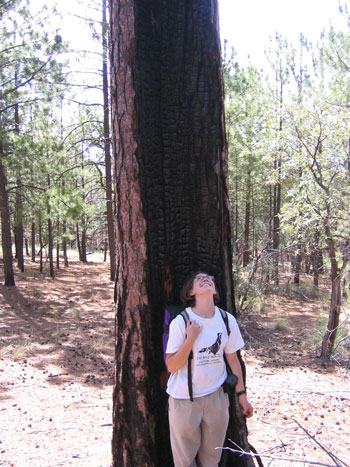 Major Findings: Striped skunk populations showed genetic structure by mountain range with unpredictable dispersal routes likely non-riparian in straight-line distances. This unpredictable dispersal pattern can make disease mapping or habitat preservation problematic. Striped skunks had a stable genetically diverse population, however, were found infrequently in urban environments (21% of all striped individuals) and had decreasing population trends in areas where they overlapped hooded skunks. Hooded skunks were common in urban areas (72% of all hooded skunks), with rapidly expanding newly established populations. Hooded skunks also appeared to disperse predominantly using riparian corridors over straight-line distances with populations strongly structured by river basin. Hooded skunks may outcompete striped skunks in urban areas, possibly due to better adaptation to xeric environments. Results indicate that a species' use of dispersal corridors is unpredictable; willingness to use established dispersal corridors may correspond to environmental conditions in which an animal adapted. However, wildlife corridors and wildlife habitat could serve both as a means for dispersal as well as permanent habitat. These results indicate similar species have may have different distribution and dispersal patterns, as well as different management implications.
Major Findings: Striped skunk populations showed genetic structure by mountain range with unpredictable dispersal routes likely non-riparian in straight-line distances. This unpredictable dispersal pattern can make disease mapping or habitat preservation problematic. Striped skunks had a stable genetically diverse population, however, were found infrequently in urban environments (21% of all striped individuals) and had decreasing population trends in areas where they overlapped hooded skunks. Hooded skunks were common in urban areas (72% of all hooded skunks), with rapidly expanding newly established populations. Hooded skunks also appeared to disperse predominantly using riparian corridors over straight-line distances with populations strongly structured by river basin. Hooded skunks may outcompete striped skunks in urban areas, possibly due to better adaptation to xeric environments. Results indicate that a species' use of dispersal corridors is unpredictable; willingness to use established dispersal corridors may correspond to environmental conditions in which an animal adapted. However, wildlife corridors and wildlife habitat could serve both as a means for dispersal as well as permanent habitat. These results indicate similar species have may have different distribution and dispersal patterns, as well as different management implications. -
Time Period: August 2004 – May 2008
-
Students: Nicolas Ramos-Lara
-
Location: Sierra de San Pedro Mártir, Baja California, Mexico
-
 Major Questions: 1. What is the current situation of the arboreal squirrels of Mexico (review chapter)
2. Do Mearns’s squirrels have specific habitat requirements for nesting?
3. Do home-range dynamics and habitat use of Mearns’s squirrels differ from other congeners?
4. Do life-history and behavioral tactics of Mearns’s squirrels differ from other congeners?
Major Questions: 1. What is the current situation of the arboreal squirrels of Mexico (review chapter)
2. Do Mearns’s squirrels have specific habitat requirements for nesting?
3. Do home-range dynamics and habitat use of Mearns’s squirrels differ from other congeners?
4. Do life-history and behavioral tactics of Mearns’s squirrels differ from other congeners? -
Major Findings: 1. In Mexico, there are 14 recognized species of arboreal squirrels of which four are endemic, with the states of Chiapas and San Luis Potosi possessing the greatest diversity. 2. Presently, all species are listed under some category of risk by IUCN, seven by Mexico’s SEMARNAT, and only one by CITES. 3. Our literature survey yielded 37 publications revealing that a dearth of scientific information still exists on the arboreal squirrels of Mexico. 4. States with a greater diversity of arboreal squirrels also have higher annual wood productions, which may pose a serious threat to their persistence. 5. Mearns’s squirrels rely primarily on tree cavities for nests, with nest tree species, nest tree condition, nest tree size (DBH), canopy cover, and occurrence of white firs (Abies concolor) as important characteristics of the habitat for nesting. 6. Without larderhoards (middens), home-range dynamics of Mearns’s squirrels are similar to nonterritorial squirrels of the genus Sciurus, suggesting that middens played an important role in the evolution of territoriality in Tamiasciurus. 7. Using satellite imagery, I found that remote areas in the Sierra de San Pedro Mártir appear to have suitable habitat for the species. 8. Survival of adult Mearns’s squirrels was influenced by sex and body mass. 9. Mearns’s squirrels are heavier and apparently also larger than other congeners, possibly in part as an adaptation to feed on large pine cones (Pinus). 10. Interyear variation in weather and food supply strongly influenced fitness-related traits and behavior of Mearns’s squirrels.
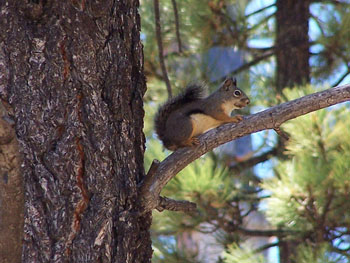
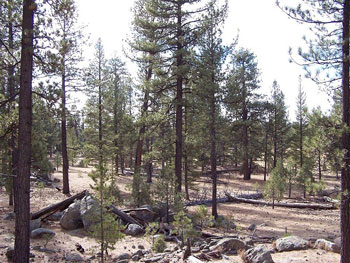
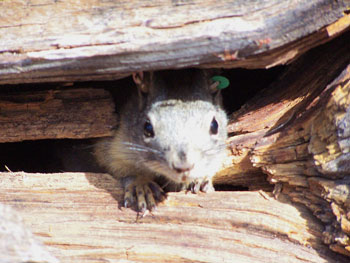
-
Time Period: 2006-2007
-
Student: Geoffrey Palmer
-
Location: Biscayne National Park, FL, U.S.A.
-
 Major Questions: What is the current status and distribution of an introduced population of Mexican red-bellied squirrels (Sciurus aureogaster)? What is the nesting behavior and habitat use of red-bellied squirrels in a novel environment? What impacts is the squirrel having in the National Park? What potential impacts could this species have if it continues to spread?
Major Questions: What is the current status and distribution of an introduced population of Mexican red-bellied squirrels (Sciurus aureogaster)? What is the nesting behavior and habitat use of red-bellied squirrels in a novel environment? What impacts is the squirrel having in the National Park? What potential impacts could this species have if it continues to spread? -
Major Findings: Red-bellied squirrels were found throughout the mixed-hardwood forest of Elliott Key. Evidence of squirrels was found on Sands Key to the north and on Old Rhodes Key to the south. No evidence of squirrels was found on Adam’s Key. Red-bellied squirrels built nests in larger, taller trees than randomly available in the forest, with nests most often built on the north side of the nest tree. Nest trees had more access routes and
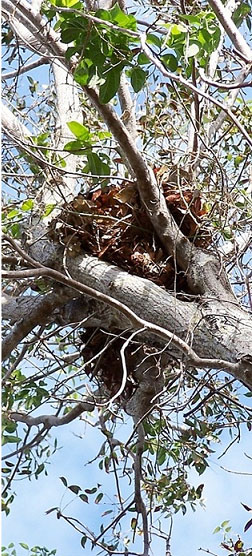 more trees immediately surrounding the nest tree than random trees. Habitat plots around nest trees had higher canopy cover, basal area, and numbers of live trees; but lower recent hurricane damage, and fewer shrub stems. Overall, red-bellied squirrels introduced to Elliott Key exhibit similar nest site selection behavior to squirrels in their native range and to other tree squirrels.
Although nests were only found in mixed-hardwood forest, there was evidence that squirrels forage and collect nesting materials in mangrove and buttonwood forests. Squirrels relied on a number of native plants for food, and during the dry months of January-March, they clipped branch tips and damaged a number of trees. We recorded some evidence that squirrels utilized Florida tree snails (Liguus sp.), a species of conservation concern, as a food source. Potential impacts from spread include competition with a number of federally endangered rodents: Key Largo woodrat, Key Largo cotton mouse, and Big Cypress fox squirrel.
more trees immediately surrounding the nest tree than random trees. Habitat plots around nest trees had higher canopy cover, basal area, and numbers of live trees; but lower recent hurricane damage, and fewer shrub stems. Overall, red-bellied squirrels introduced to Elliott Key exhibit similar nest site selection behavior to squirrels in their native range and to other tree squirrels.
Although nests were only found in mixed-hardwood forest, there was evidence that squirrels forage and collect nesting materials in mangrove and buttonwood forests. Squirrels relied on a number of native plants for food, and during the dry months of January-March, they clipped branch tips and damaged a number of trees. We recorded some evidence that squirrels utilized Florida tree snails (Liguus sp.), a species of conservation concern, as a food source. Potential impacts from spread include competition with a number of federally endangered rodents: Key Largo woodrat, Key Largo cotton mouse, and Big Cypress fox squirrel. -
Our work documenting the threat of spread beyond the borders of Biscayne National Park and the potential impacts squirrels could have on native species led to the decision to attempt an eradication of the species. The National Park Service hopes to complete the eradication in 2013.
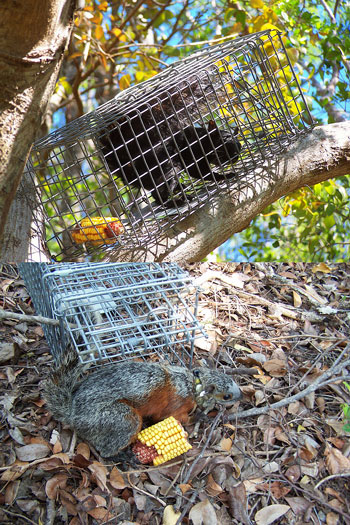

-
Time Period: 2004 - 2006
-
Student: Katharine M. Leonard
-
Location: Pinaleño (Graham) Mountains, Graham County, southeastern Arizona (Coronado National Forest). White Mountains, Greenlee County, east-central Arizona (Apache-Sitgreaves National Forest).
-
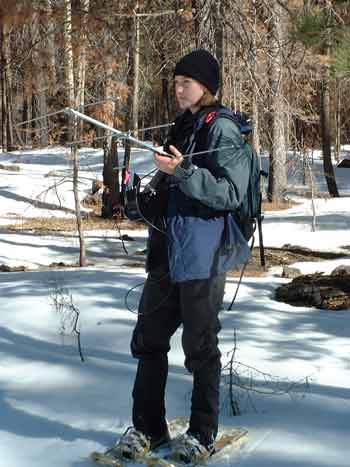 Major Questions/Objectives: Populations at the edge of their geographic range may inhabit areas with different habitat structure and resources than central populations, and thus may differ in population dynamics. Understanding these unique characteristics is especially important for populations of high conservation priority, such as the endangered Mt. Graham red squirrel (Tamiasciurus hudsonicus grahamensis). The Mt. Graham red squirrel (MGRS) is endemic to southeastern Arizona, represents the
southernmost red squirrel population and is found at lower densities than conspecifics in the center of the range. To determine if differences are due to conditions at the southern periphery of the range, we compared habitat characteristics, demography, body mass, space use and nesting behavior with another subspecies located at the southern edge of the range, the Mogollon red squirrel (T. h. mogollonensis).
In addition, we studied demography and behavior of MGRS inhabiting areas within and outside areas of low-intensity burn following the Nuttall fire complex in the Pinaleño Mountains (summer 2004).
Major Questions/Objectives: Populations at the edge of their geographic range may inhabit areas with different habitat structure and resources than central populations, and thus may differ in population dynamics. Understanding these unique characteristics is especially important for populations of high conservation priority, such as the endangered Mt. Graham red squirrel (Tamiasciurus hudsonicus grahamensis). The Mt. Graham red squirrel (MGRS) is endemic to southeastern Arizona, represents the
southernmost red squirrel population and is found at lower densities than conspecifics in the center of the range. To determine if differences are due to conditions at the southern periphery of the range, we compared habitat characteristics, demography, body mass, space use and nesting behavior with another subspecies located at the southern edge of the range, the Mogollon red squirrel (T. h. mogollonensis).
In addition, we studied demography and behavior of MGRS inhabiting areas within and outside areas of low-intensity burn following the Nuttall fire complex in the Pinaleño Mountains (summer 2004). -
Major Findings: We found that mean and minimum daily temperatures were higher at Mt. Graham whereas maximum temperatures were higher in the White Mountains, male Mogollon red squirrels were heavier than male Mt. Graham red squirrels in all seasons and female Mogollon red squirrels were slightly heavier than female Mt. Graham red squirrels in spring, proportion of squirrels in reproductive condition was lower in female Mogollon red squirrels, Mogollon red squirrels had smaller home ranges, used different types of nests and traveled less distance to nest than Mt. Graham red squirrels. There were no differences in annual rainfall, seedfall, habitat characteristics or survival between mountain ranges. Localized conditions appear to account for the disparity between populations. These differences demonstrate the importance of evaluating attributes of peripheral populations for maximizing persistence and intraspecific diversity.
-
Upon examining MGRS physical and behavioral traits between areas of no burn and low-intensity burn from the 2004 Nuttall fire, we found that body mass, proportion of individuals in reproductive condition, and distance squirrels traveled to nest did not differ between squirrels within and outside the perimeter of the fire. Within the perimeter, red squirrels had smaller home ranges and shifted territories less frequently and had shorter distances from their previously held territories than squirrels outside the perimeter. Mount Graham red squirrels evolved with patchy, low-intensity fires like those that burned in mixed-conifer forests in the Pinaleño Mountains and may be able to persist in areas affected by this level of disturbance.
-
Time Period - 2002 – 2005
-
Student: Deborah J. C. Buecher
-
Location: Sabino Canyon Recreational Area, Santa Catalina Mountains, near Tucson, Arizona (Coronado National Forest).
-
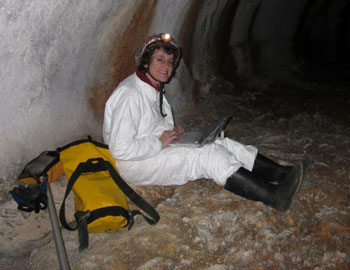 Major Questions: Riparian corridors in xeric environments act as contact zones between deciduous streamside and arid-adapted biotic communities, providing landscape complexity critical for wildlife. For bats foraging along riparian zones, this ecotone can supply food resources, day-roosts and access to drinking water. Yet, riverine areas are sensitive to anthropogenic alteration of habitat. The first goal of our research was to investigate the bat assemblage (using mist netting) at a wildland-urban interface associated with a Sonoran Desert riparian corridor, determine species richness, and assess differential spatial and temporal resource use.
The second goal of our research was to investigate how rugged canyons in the desert Southwest could be modeled to predict where food resources for insectivorous bats might be concentrated, as bats often anticipate productive feeding areas, given their spatial memory and knowledge of the landscape. This information could aid in better assessments of bat species diversity in canyon corridors.
Major Questions: Riparian corridors in xeric environments act as contact zones between deciduous streamside and arid-adapted biotic communities, providing landscape complexity critical for wildlife. For bats foraging along riparian zones, this ecotone can supply food resources, day-roosts and access to drinking water. Yet, riverine areas are sensitive to anthropogenic alteration of habitat. The first goal of our research was to investigate the bat assemblage (using mist netting) at a wildland-urban interface associated with a Sonoran Desert riparian corridor, determine species richness, and assess differential spatial and temporal resource use.
The second goal of our research was to investigate how rugged canyons in the desert Southwest could be modeled to predict where food resources for insectivorous bats might be concentrated, as bats often anticipate productive feeding areas, given their spatial memory and knowledge of the landscape. This information could aid in better assessments of bat species diversity in canyon corridors. 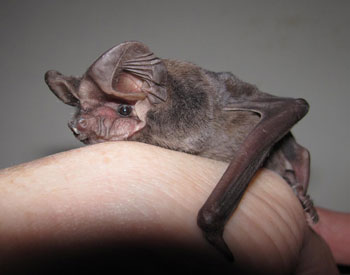
-
Major Findings: Bat capture rate was high (17 species and 961 individuals) considering the aridity of the area. Seventeen species were documented, representing three bat families: Vespertilionidae, Molossidae and Phyllostomidae. We found that bats distribute themselves spatially along the canyon when water is plentiful, partitioning water resources where possible. When seasonal drying reduces water availability to isolated pools, numbers of species and individuals increase at remaining pools as bats compete for limited water. We also found distinct temporal variation in pool-use by the most frequently captured species. In addition, we proposed a hypothetical model, using a multidisciplinary approach to apply hydrologic models to evaluation of other 'fluids', such as cold-air drainage, in the canyons of the arid Southwest. Because small insects move through air much like swimming through molasses, they may be at the mercy of these airflow patterns. An understanding that insects are 'pooled' by the fluid nature of air may allow bats to anticipate foraging opportunities on patchy food resources and may enable bat ecologists to more accurately track bat diversity. The Sabino Canyon riparian corridor provides critical habitat for bats, however increased urbanization, associated groundwater extraction and recent forest fires, aggravated by regional drought, threaten this biologically diverse system. Riverine environments in arid landscapes are crucial for wildlife, both for foraging and as migratory corridors. Loss and degradation of riparian areas in arid regions put wildlife, particularly bats, at risk and preservation of this ecologically important resource should be a management priority.
-
Time Period: 2002 - 2005
-
Student: Carol A. Coates
-
Location: Las Cienegas National Conservation Area and Ft. Huachuca Military Base, AZ, USA Upper San Pedro River Valley, Ejido Morelos, Sonora, Mexico
-
 Major Questions/Objectives: Study objectives were: 1) to determine if areas identified as potential re-introduction sites were suitable to support BTPD populations by comparing habitat characteristics with an occupied BTPD colony in northern Sonora, Mexico, 2) assess what pre-release management actions may be required in these areas, and 3) determine whether the presence of prairie dogs could potentially affect avian grassland species diversity in Arizona.
Major Questions/Objectives: Study objectives were: 1) to determine if areas identified as potential re-introduction sites were suitable to support BTPD populations by comparing habitat characteristics with an occupied BTPD colony in northern Sonora, Mexico, 2) assess what pre-release management actions may be required in these areas, and 3) determine whether the presence of prairie dogs could potentially affect avian grassland species diversity in Arizona. -
Major Findings: There was considerable overlap in habitat variables between the occupied BTPD colony in Sonora and potential re-introduction sites in Arizona. However, greater densities of grass, shrubs, and trees were found on the potential sites Arizona sites than on the occupied Sonora colony. Though grass species diversity did not differ between the Arizona and Sonora sites, grass species diversity was much lower on the Ft. Huachuca site, mainly due to large amounts of introduced Lehmann lovegrass. Management actions needed on the Arizona sites to render them more suitable for BTPD introduction include mowing grass and decreasing shrub and tree densities possibly through use of prescribed fire.
-
Using fixed-radius point counts, avian species diversity was determined to be higher on the Arizona sites that on the Sonora sites. The greater number of avian species on the Arizona sites can be attributed to higher shrub densities and wider range of physical and environmental features, such as ephemeral streams and mesquite thickets. The reintroduction of BTPD on the Arizona sites would likely alter plant species composition and structure and, therefore, the abundance of avian species, especially those species requiring trees and shrubs for nesting and foraging. However, avian species that require open spaces, such as shrikes and larks, or the presence of abandoned small mammal burrows for nesting, such as the burrowing owl, may increase on the Arizona sites due to BTPD habitat management practices.
-
Based on the vegetation characteristics, proximity to land protected from development, and historical presence of BTPD, the Arizona sites appear to be suitable locations for re-introduction of BTPD. Pre-release habitat management, such as mowing and prescribed fire, as well as a more fine-scale assessment of specific release sites (especially soil characteristics) will be required before attempting to return Black-tailed prairie dogs to southern Arizona.
-
Time Period: 2001 - 2004
-
Student: Bret S. Pasch
-
Location: Chiricahua National Monument (National Park Service), Chiricahua Mountains, southeast of Willcox, Cochise County, Arizona.
-
 Major Questions/Objectives: Chiricahua fox squirrels (Sciurus nayaritensis chiricahuae) are endemic to the Chiricahua Mountains of southeastern Arizona. A paucity of natural history information and uncertain conservation status served as impetus for us to initiate a descriptive ecological study of the species. In addition, we examined the impacts of human suppression of fire on patterns of habitat use and survival of Chiricahua fox squirrels in fire-suppressed and fire-prescribed areas of the Chiricahua Mountains. We used radiotelemetry techniques to elucidate space and habitat use, survivorship, and fire impacts in our investigation.
Major Questions/Objectives: Chiricahua fox squirrels (Sciurus nayaritensis chiricahuae) are endemic to the Chiricahua Mountains of southeastern Arizona. A paucity of natural history information and uncertain conservation status served as impetus for us to initiate a descriptive ecological study of the species. In addition, we examined the impacts of human suppression of fire on patterns of habitat use and survival of Chiricahua fox squirrels in fire-suppressed and fire-prescribed areas of the Chiricahua Mountains. We used radiotelemetry techniques to elucidate space and habitat use, survivorship, and fire impacts in our investigation. -
Major Findings: We found that Chiricahua fox squirrels differed in several capacities from more widespread species of tree squirrels. Females had a mean of 1.6 (range 1-2) offspring per litter and we found an overall population density of 0.07/ha, both parameters lower than other North American tree squirrels. Seasonal fluctuations in body mass and space use generally paralleled other species of tree squirrels with some notable exceptions. Male Chiricahua fox squirrels maintained a fairly constant body mass and large home range size throughout the year, in contrast to other tree squirrel species that typically show a reduction in both measures in non-mating seasons. Extreme spatial and temporal fluctuations of food experienced by Chiricahua fox squirrels might result in annual patterns in space use and body mass that differ from tree squirrels living in forests with a greater abundance of food.
-
We found differences in habitat use and survival of squirrels in areas of the Chiricahua Mountains with differing fire regimes (suppressed vs. prescribed). Core areas of squirrels within fire-suppressed areas were larger and contained more understory shrubs than core areas of squirrels in fire-prescribed areas. Shrub cover and canopy heterogeneity influenced core-area size and distance traveled, and squirrels that were depredated traveled farther than conspecifics that survived, but shrub cover and canopy heterogeneity were not directly associated with squirrel survival. Suppression-induced increases in understory vegetation might force squirrels to travel greater distances to meet energetic requirements and thereby increase predation risk. Retention of mature forested canyons and restoration of natural fire regimes will be important for the persistence of Chiricahua fox squirrels.
-
Time Period: 2001 - 2004
-
Student: Andrew J. Edelman
-
Location: Pinaleño (Graham) Mountains, Graham County, southeastern Arizona (Coronado National Forest).
-
 Major Questions/Objectives: Abert’s squirrels (Sciurus aberti) are reported to depend on ponderosa pine (Pinus ponderosa) for food and nest sites. Introduced Abert’s squirrels in the Pinaleño Mountains of Arizona, however, occupy mixed-conifer forests that contain almost no ponderosa pine (about 2%). We examined Abert’s squirrel nest site selection, diet, and home range in this novel habitat.
In addition, we examined the potential for interspecific competition for nest sites and food resources between co-occurring native Mt. Graham red squirrels (Tamiasciurus hudsonicus grahamensis) and non-native Abert’s squirrels in the Pinaleño Mountains.
Major Questions/Objectives: Abert’s squirrels (Sciurus aberti) are reported to depend on ponderosa pine (Pinus ponderosa) for food and nest sites. Introduced Abert’s squirrels in the Pinaleño Mountains of Arizona, however, occupy mixed-conifer forests that contain almost no ponderosa pine (about 2%). We examined Abert’s squirrel nest site selection, diet, and home range in this novel habitat.
In addition, we examined the potential for interspecific competition for nest sites and food resources between co-occurring native Mt. Graham red squirrels (Tamiasciurus hudsonicus grahamensis) and non-native Abert’s squirrels in the Pinaleño Mountains. -
Major Findings: Abert’s squirrel dreys (i.e., spherical nests) were built adjacent to the trunk at 75% of the tree height. Dreys were found in 5 different conifer species and 2% were in ponderosa pine. Drey trees were larger and had more access routes than did random trees. The structural characteristics of drey trees in the Pinaleños population also were very similar to drey trees used by natural populations of Abert’s squirrels in ponderosa pine forests. Structural features such as tree size and access routes appear to be more important to selection of drey sites than tree species.
-
Through observations of marked animals, we found that individuals in the mixed-conifer forest ate similar food items as Abert’s squirrels in ponderosa pine forests, including seeds, inner bark, buds, and fungi, but 5 conifer species were used as food sources. Douglas-fir (Pseudotsuga menziesii) and southwestern white pine (Pinus strobiformis) were the most frequently eaten conifer species. Nests of Abert’s squirrels also were detected in all tree species. Our results for nest site selection and food suggest that the dependence of Abert’s squirrels on ponderosa pine is not as strong as previously reported.
-
Abert’s squirrel home-range size, home-range overlap with females, and movement distances increased for males from nonmating to mating seasons. Home-range size and overlap characteristics of females remained consistent between seasons, but movement distances were reduced during the mating season. Non-mating season home ranges in our study were smaller than home ranges observed in ponderosa pine forest. Abert’s squirrels in mixed-conifer forest may have small home ranges because resource quality is higher than in ponderosa pine forest or due to competition for space with co-occurring Mount Graham red squirrels.
-
Comparison of nest use between Mt. Graham red squirrels and Abert’s squirrels at different scales (nest, nest tree, and nest site) revealed contrasting results. Competition for nests and nest trees appears unlikely given the dissimilarity in use of nest types and tree characteristics. Abert’s squirrels predominately used dreys, whereas red squirrels mostly used cavity nests. Neither squirrel species occupied a nest used by the other species. Abert’s squirrel nest sites were found in a wider range of microhabitats including almost all microhabitats in which red squirrel nest sites were located. Although there was significant overlap, each species showed distinct trends in microhabitat. In general, red squirrel nest sites were characterized as more densely forested areas dominated by corkbark fir (Abies lasiocarpa var. arizonica), whereas Abert’s squirrel nest sites were more open and contained greater tree species diversity. Overlap in microhabitat characteristics increases the likelihood of interspecific competition and could increase the vulnerability of red squirrels to extinction.
-
We also used remote photography to assess the frequency of inter- and intra-specific kleptoparasitism and species richness at Mt. Graham red squirrel middens. Remote cameras and conifer cones were placed at occupied and unoccupied middens, and random sites. Species richness of small mammals was higher at red squirrel middens than random sites. Abert’s squirrels, potential kleptoparasites, were recorded only at unoccupied middens and random sites. Non-resident red squirrels were most common at unoccupied middens and rare at occupied middens and random sites. Inter- and intra-specific kleptoparasitism of red squirrel middens appears uncommon likely due to territorial behavior.
Project Details (click to expand/reduce)
Project Description & Bio:

Ganges River dolphin, Platanista gangetica gangetic, is the only cetacean species recorded in Nepal. No considerable improvements on population status have been recorded for these small isolated upstream groups (especially in Nepal) in more than two decades, in fact the range of distribution has been reduced significantly as one of the four previously important river systems now have been abandoned and abundance have declined (Smith et al., 1993; Paudel et al., 2015). Less than 30 individuals were counted visually in three river systems of Nepal (Paudel et al., 2015). Large structures like dams, flood-control structures, and embankments for irrigation projects, agriculture and hydroelectric power have impacts on the river dolphins that have led to the loss of longitudinal and lateral connectivity of habitats (Vannote et al., 1980; Ward, 1998; Ward et al., 1999; Dudgeon, 2000; Bunn and Arthington, 2002; Nilsson et al., 2005). As a consequence, clear effects on distribution, gene flow, movement patterns, and behavior have been noticed. At the same time, immense pressure from artisanal fisheries have been documented and two dolphins were entangled in the recent two years (per.obs). Management and maintenance of adequate water flows and ecologically functional habitats is thus the most important challenge for river dolphin conservation in Nepal where only barely viable populations are remaining (Richter et al., 2003; Smakhtin et al., 2007; Paudel et al., 2015). To conserve freshwater ecosystems and their associated critical endangered species, additional research is needed to establish priorities efforts for the conservation and management.

Surfacing river dolphin in Karnali river system of Nepal. Photo: S Paudel

Ganges River dolphin, Platanista gangetica gangetic, is the only cetacean species recorded in Nepal. No considerable improvements on population status have been recorded for these small isolated upstream groups (especially in Nepal) in more than two decades, in fact the range of distribution has been reduced significantly as one of the four previously important river systems now have been abandoned and abundance have declined (Smith et al., 1993; Paudel et al., 2015). Less than 30 individuals were counted visually in three river systems of Nepal (Paudel et al., 2015). Large structures like dams, flood-control structures, and embankments for irrigation projects, agriculture and hydroelectric power have impacts on the river dolphins that have led to the loss of longitudinal and lateral connectivity of habitats (Vannote et al., 1980; Ward, 1998; Ward et al., 1999; Dudgeon, 2000; Bunn and Arthington, 2002; Nilsson et al., 2005). As a consequence, clear effects on distribution, gene flow, movement patterns, and behavior have been noticed. At the same time, immense pressure from artisanal fisheries have been documented and two dolphins were entangled in the recent two years (per.obs). Management and maintenance of adequate water flows and ecologically functional habitats is thus the most important challenge for river dolphin conservation in Nepal where only barely viable populations are remaining (Richter et al., 2003; Smakhtin et al., 2007; Paudel et al., 2015). To conserve freshwater ecosystems and their associated critical endangered species, additional research is needed to establish priorities efforts for the conservation and management.
Surfacing river dolphin in Karnali river system of Nepal. Photo: S Paudel
Development of meaningful specific conservation plans for river dolphins is always denied due to lack of data on population status, underwater behavioual patterns (diel activities) and interaction with water flow ecology. Many previous studies (Shrestha, 1989; Smith et al., 1993, Jnawali and Bhuju, 2000; WWF, 2007) have only focused on population abundance estimation using visual counts without detecting observation errors and with only superficial attempts on threats analysis. However, recent studies (Paudel et al., 2014; Paudel et al., 2015; Paudel et al., 2016) have put more emphasis on the cause of the population decline and proposal for solutions. Key elements required for an effective conservation or management strategy is a reliable estimate of population size, conservation ecology, genetic information and finding ways of mitigating conflicts with human activities.
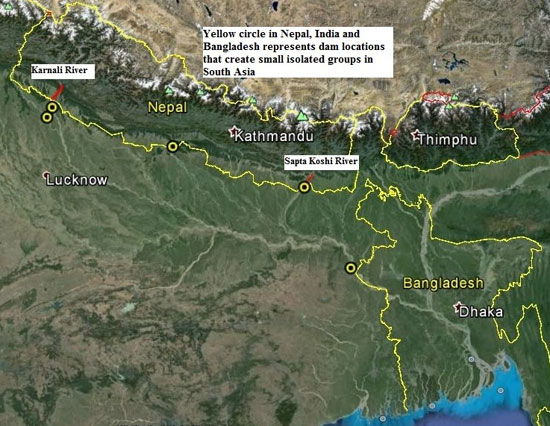
Study site, prepared by S Paudel
Study site, prepared by S Paudel
This project aims to improve scientific knowledge on Ganges river dolphins to inform management and conservation efforts for freshwater rivers where endangered aquatic species has been survived. It is also hope that strategies that are applicable for Ganges river dolphin will protect other taxa that share the same habitats like the Gharial (endangered crocodile). Following research questions will be addressed by this project:
Personal description:
Email:spaudel@email.arizona.edu/oasis.excurrent@gmail.com
Conservation research award/grants: OPCF-Hong Kong; Rufford Foundation-UK; Chicago Zoological Society/CBOT Endangered Species Grant, USA; IMATA-USA; Mohamed Bin Zayed Species Conservation Fund-United Arab Emirates; The EBS Award of the Society for Marine Mammalogy-USA.
Selected journal papers:
Shah KB, Paudel S (2016) Ecology of crocodile and dolphin in the Koshi Basin. Chapter 11 in: Doody TM, Cuddy SM, Bhatta LD (eds) Connecting flows and ecology in Nepal: current state of knowledge for the Koshi Basin. Sustainable Development Investment Portfolio (SDIP) project. CSIRO, Australia. pp 123–138
Paudel S, Levesque JC, Saavedra C, Pita C, Pal P. (2016), Characterization of the artisanal fishing communities in Nepal and potential implications for the conservation and management of Ganges River Dolphin (Platanista gangetica gangetica). PeerJ 4:e1563; DOI 10.7717/peerj.1563
Paudel S, Pal P, Cove MV, Jnawali SR, Abel G, Koprowski JL, Ranabhat R. (2015). The Endangered Ganges River dolphin (Platanista gangetica gangetica) in Nepal: abundance, habitat and conservation threats. Endangered Species Researc, 29(1):59-68. DOI: 10.3354/esr00702
Paudel, S., Timilsina, Y. P., Lewis, J., Ingersoll, T., & Jnawali, S. R. (2015). Population status and habitat occupancy of endangered river dolphins in the Karnali River system of Nepal during low water season. Marine Mammal Science, 31(2), 707-719.
Paudel, S., Raj Jnawali, S., & Ram Lamichhane, J. (2012). Use of geographic information system and direct survey methods to detect spatial distribution of wild olive (Olea cuspidata Wall.) from high mountain forests of northwestern Nepal. Journal of Sustainable Forestry, 31(7), 674-686.
Paudel, S., Magranti, T., & Lamichhane, J. R. (2011). Antimicrobial activity of wild olive crude extracts in vitro. International Journal of Pharma Sciences and Research, 2(3), 110-113.
Research in Media (related to PhD project):
Nepal’s endangered river dolphins return (2015/09/12)
http://www.scidev.net/south-asia/biodiversity/news/nepal-s-endangered-river-dolphins-return.html
Number of freshwater dolphins doubles in two decades: Study (2014/09/14)
http://www.ekantipur.com/2014/09/14/capital/number-of-freshwater-dolphins-doubles-in-two-decades-study/395003.html
Endangered dolphin spotted (2014/04/02)
http://kathmandupost.ekantipur.com/news/2014-04-02/endangered-dolphin-spotted.html
Dolphin survey from Dec (2013/11/30)
http://kathmandupost.ekantipur.com/news/2013-11-30/dolphin-survey-from-dec.html
Prey dearth, habitat loss put Karnali river dolphins on ‘edge of extinction’ (2012/09/01)
http://kathmandupost.ekantipur.com/printedition/news/2012-09-01/prey-dearth-habitat-loss-put-karnali-river-dolphins-on-edge-of-extinction.html
Shah KB, Paudel S (2016) Ecology of crocodile and dolphin in the Koshi Basin. Chapter 11 in: Doody TM, Cuddy SM, Bhatta LD (eds) Connecting flows and ecology in Nepal: current state of knowledge for the Koshi Basin. Sustainable Development Investment Portfolio (SDIP) project. CSIRO, Australia. pp 123–138
Nepal’s endangered river dolphins return (2015/09/12)
http://www.scidev.net/south-asia/biodiversity/news/nepal-s-endangered-river-dolphins-return.html
Number of freshwater dolphins doubles in two decades: Study (2014/09/14)
http://www.ekantipur.com/2014/09/14/capital/number-of-freshwater-dolphins-doubles-in-two-decades-study/395003.html
Developing an ex situ propagation strategy of Mount Graham red squirrels (Tamiasciurus fremonti grahamensis) to positively affect their chances of survival after release into the wild
Project Details (click to expand/reduce)
Terrestrial ecology of the endangered Sonoran tiger salamander, Ambystoma mavortium stebbinsi
Project Details (click to expand/reduce)
If you build it will they come? Artificial midden creation and settlement by Mt. Graham red squirrels
Time Period: January 2017 - May 2019
Project Details (click to expand/reduce)
Population and spatial ecology of the Pinaleño white-bellied vole, Microtus longicaudus leucophaeus
Time Period:Fall 2017 -Present
Project Details (click to expand/reduce)
Spatial and social dynamics of Harris's antelope ground squirrels
Project Details (click to expand/reduce)
Space Use, Sociality, and Foraging Ecology of Antelope Jackrabbits
Project Details (click to expand/reduce)
Effects of Re-establishing Black-tailed Prairie Dog Colonies on Southeastern Arizona Grasslands
Project Details (click to expand/reduce)
Can red squirrel middens influence species diversity?
Project Details (click to expand/reduce)
Competition between native and introduced species
Project Details (click to expand/reduce)
Proximate cues and ultimate consequences for natal dispersal and settlement in an altered forest landscape: influence of experience, behavior, and habitat
Project Details (click to expand/reduce)
Road and traffic effects on movements and space use of red squirrels
Project Details (click to expand/reduce)
Mammal detection and identification using non-invasive method: hairtube sampling
Project Details (click to expand/reduce)
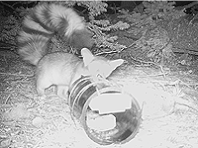
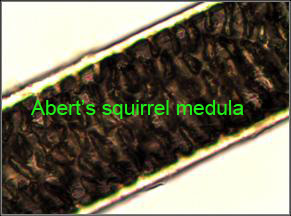

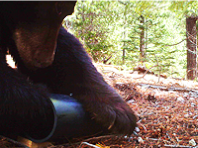
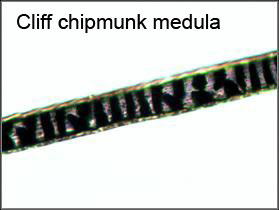
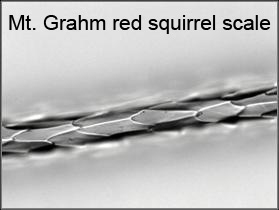
Ecology of Neotropical Tree Squirrels
Project Details (click to expand/reduce)
What can endemics tell us? Space use and ecology of the endemic Arizona gray squirrel
Project Details (click to expand/reduce)
The Socioecology, Mating System and Behavior of Round-Tailed Ground Squirrels (Xerospermophilus tereticaudus)
Project Details (click to expand/reduce)
 Major Findings: Solitary individuals and integrated groups of highly related individuals represent two ends of the sociality spectrum. The sociality of a species may impact behavior, reproductive ecology, mating systems and overall fitness consequences. Social behaviors include any interaction among members of a group that maintains group structure. A large body of knowledge exists for life history characteristics and sociality of ground-dwelling sciurids, including several overarching models explaining the evolution of sociality. These models predict round-tailed ground squirrels (Xerospermophilus tereticaudus) to be solitary based on small body size (~125g), relatively long period of activity (January-June) and short period of adult-juvenile overlap; however, previous behavioral observations suggest round-tailed ground squirrels may be more social with a clustered matrilineal structure, suggesting they may represent a unique outlier in ground squirrel sociality models.
Major Findings: Solitary individuals and integrated groups of highly related individuals represent two ends of the sociality spectrum. The sociality of a species may impact behavior, reproductive ecology, mating systems and overall fitness consequences. Social behaviors include any interaction among members of a group that maintains group structure. A large body of knowledge exists for life history characteristics and sociality of ground-dwelling sciurids, including several overarching models explaining the evolution of sociality. These models predict round-tailed ground squirrels (Xerospermophilus tereticaudus) to be solitary based on small body size (~125g), relatively long period of activity (January-June) and short period of adult-juvenile overlap; however, previous behavioral observations suggest round-tailed ground squirrels may be more social with a clustered matrilineal structure, suggesting they may represent a unique outlier in ground squirrel sociality models.
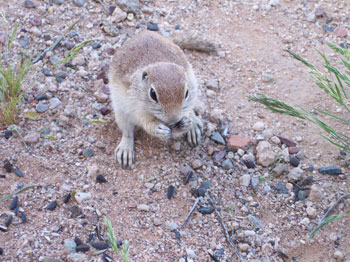
Our findings include, round-tailed ground squirrels' active season closely followed patterns of precipitation and peak resource availability. Body mass differed between males and females, across years, and time periods. Males were heavier than females at emergence, prior to mating and pre-hibernation, but not when females began gestation. Emergence of litters and litter size was correlated with amount and timing of winter rainfall. Foraging and vigilance behaviors compose the majority of the activity budget, but differ in that males spend a greater proportion of time foraging, whereas females spend a greater proportion of time vigilant. Rates of amicable and agonistic interactions between adults were low (≤0.69/hr) with no relationship between relatedness of individuals and rates of social interactions. No population substructure was evident with Bayesian analyses, global or pairwise FST values, and average relatedness among females was not significantly different than males. Contrary to previous behavioral studies, our population of round-tailed ground squirrels does not have high levels of social behavior, nor form significant subpopulation genetic structuring. Polygyny was evident in all years except 2007 and multiple paternity occurred in the majority of litters (55%) with 2.5 sires/litter and litter size was positively correlated with the number of sires. Round-tailed ground-squirrels have a polygynandrous mating system, which fits the predictions of the ground-squirrel sociality models.
Movements of Mesocarnivores in a Fragmented Desert Environment
Project Details (click to expand/reduce)
Ecology of the endemic Mearns’s squirrel (Tamiasciurus mearnsi) in Baja California, Mexico
Project Details (click to expand/reduce)
Assessment of an introduced population of Mexican red-bellied squirrels (Sciurus aureogaster) in Biscayne National Park, Florida, USA
Project Details (click to expand/reduce)
Variation among red squirrel populations: Ecological differences at the edge of their range and response to fire.
Project Details (click to expand/reduce)
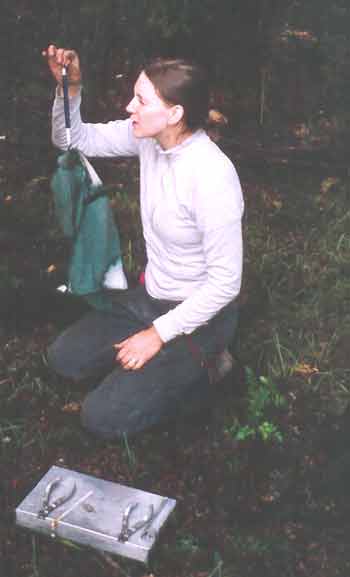
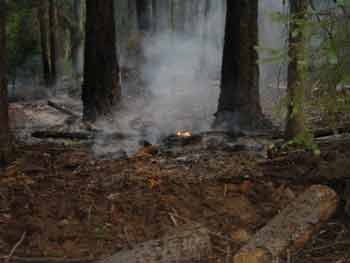
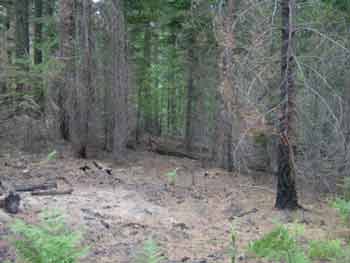
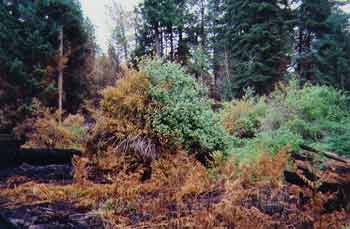

Bat diversity, resource use and activity patterns along a Sonoran Desert riparian corridor
Project Details (click to expand/reduce)
Suitability of Potential Habitat for the Extirpated Arizona Black-tailed Prairie Dog
Project Details (click to expand/reduce)
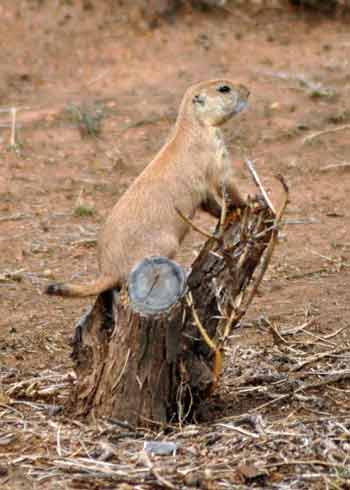
Space use, ecology, & conservation of Chiricahua fox squirrels
Project Details (click to expand/reduce)
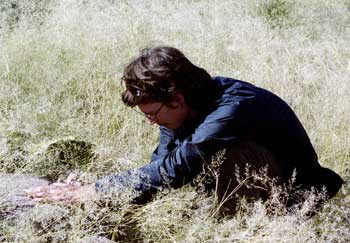
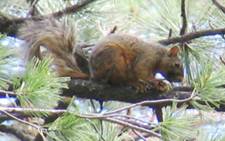
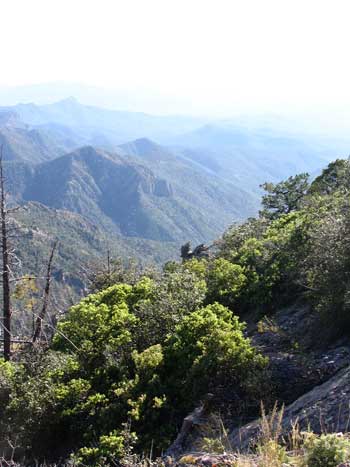
The ecology of an introduced population of Abert’s squirrels in a mixed-conifer forest.
Project Details (click to expand/reduce)
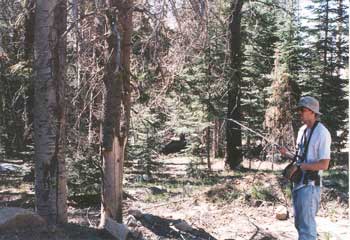
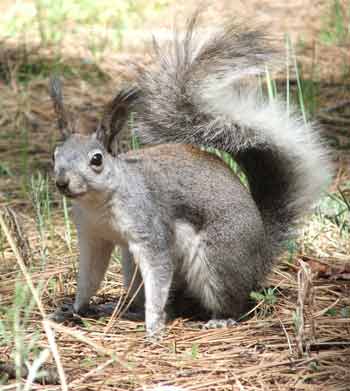
Project Details (click to expand/reduce)
Project Details (click to expand/reduce)
Project Details (click to expand/reduce)
Project Details (click to expand/reduce)
Project Details (click to expand/reduce)
Project Details (click to expand/reduce)
Project Details (click to expand/reduce)
Project Details (click to expand/reduce)
Project Details (click to expand/reduce)
Project Details (click to expand/reduce)
Project Details (click to expand/reduce)
Project Details (click to expand/reduce)






Project Details (click to expand/reduce)
Project Details (click to expand/reduce)
Project Details (click to expand/reduce)
 Major Findings: Solitary individuals and integrated groups of highly related individuals represent two ends of the sociality spectrum. The sociality of a species may impact behavior, reproductive ecology, mating systems and overall fitness consequences. Social behaviors include any interaction among members of a group that maintains group structure. A large body of knowledge exists for life history characteristics and sociality of ground-dwelling sciurids, including several overarching models explaining the evolution of sociality. These models predict round-tailed ground squirrels (Xerospermophilus tereticaudus) to be solitary based on small body size (~125g), relatively long period of activity (January-June) and short period of adult-juvenile overlap; however, previous behavioral observations suggest round-tailed ground squirrels may be more social with a clustered matrilineal structure, suggesting they may represent a unique outlier in ground squirrel sociality models.
Major Findings: Solitary individuals and integrated groups of highly related individuals represent two ends of the sociality spectrum. The sociality of a species may impact behavior, reproductive ecology, mating systems and overall fitness consequences. Social behaviors include any interaction among members of a group that maintains group structure. A large body of knowledge exists for life history characteristics and sociality of ground-dwelling sciurids, including several overarching models explaining the evolution of sociality. These models predict round-tailed ground squirrels (Xerospermophilus tereticaudus) to be solitary based on small body size (~125g), relatively long period of activity (January-June) and short period of adult-juvenile overlap; however, previous behavioral observations suggest round-tailed ground squirrels may be more social with a clustered matrilineal structure, suggesting they may represent a unique outlier in ground squirrel sociality models.

Our findings include, round-tailed ground squirrels' active season closely followed patterns of precipitation and peak resource availability. Body mass differed between males and females, across years, and time periods. Males were heavier than females at emergence, prior to mating and pre-hibernation, but not when females began gestation. Emergence of litters and litter size was correlated with amount and timing of winter rainfall. Foraging and vigilance behaviors compose the majority of the activity budget, but differ in that males spend a greater proportion of time foraging, whereas females spend a greater proportion of time vigilant. Rates of amicable and agonistic interactions between adults were low (≤0.69/hr) with no relationship between relatedness of individuals and rates of social interactions. No population substructure was evident with Bayesian analyses, global or pairwise FST values, and average relatedness among females was not significantly different than males. Contrary to previous behavioral studies, our population of round-tailed ground squirrels does not have high levels of social behavior, nor form significant subpopulation genetic structuring. Polygyny was evident in all years except 2007 and multiple paternity occurred in the majority of litters (55%) with 2.5 sires/litter and litter size was positively correlated with the number of sires. Round-tailed ground-squirrels have a polygynandrous mating system, which fits the predictions of the ground-squirrel sociality models.
Project Details (click to expand/reduce)
Project Details (click to expand/reduce)
Project Details (click to expand/reduce)
Project Details (click to expand/reduce)

Project Details (click to expand/reduce)
Suitability of Potential Habitat for the Extirpated Arizona Black-tailed Prairie Dog
Project Details (click to expand/reduce)

Space use, ecology, & conservation of Chiricahua fox squirrels
Project Details (click to expand/reduce)



The ecology of an introduced population of Abert’s squirrels in a mixed-conifer forest.
Project Details (click to expand/reduce)


